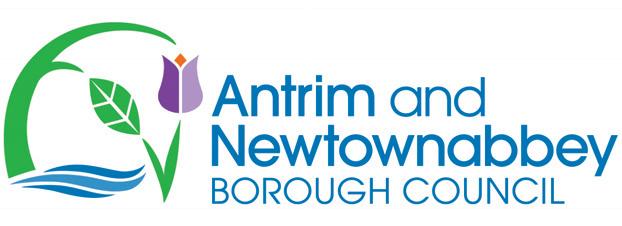

Sponsored by



Sponsored by
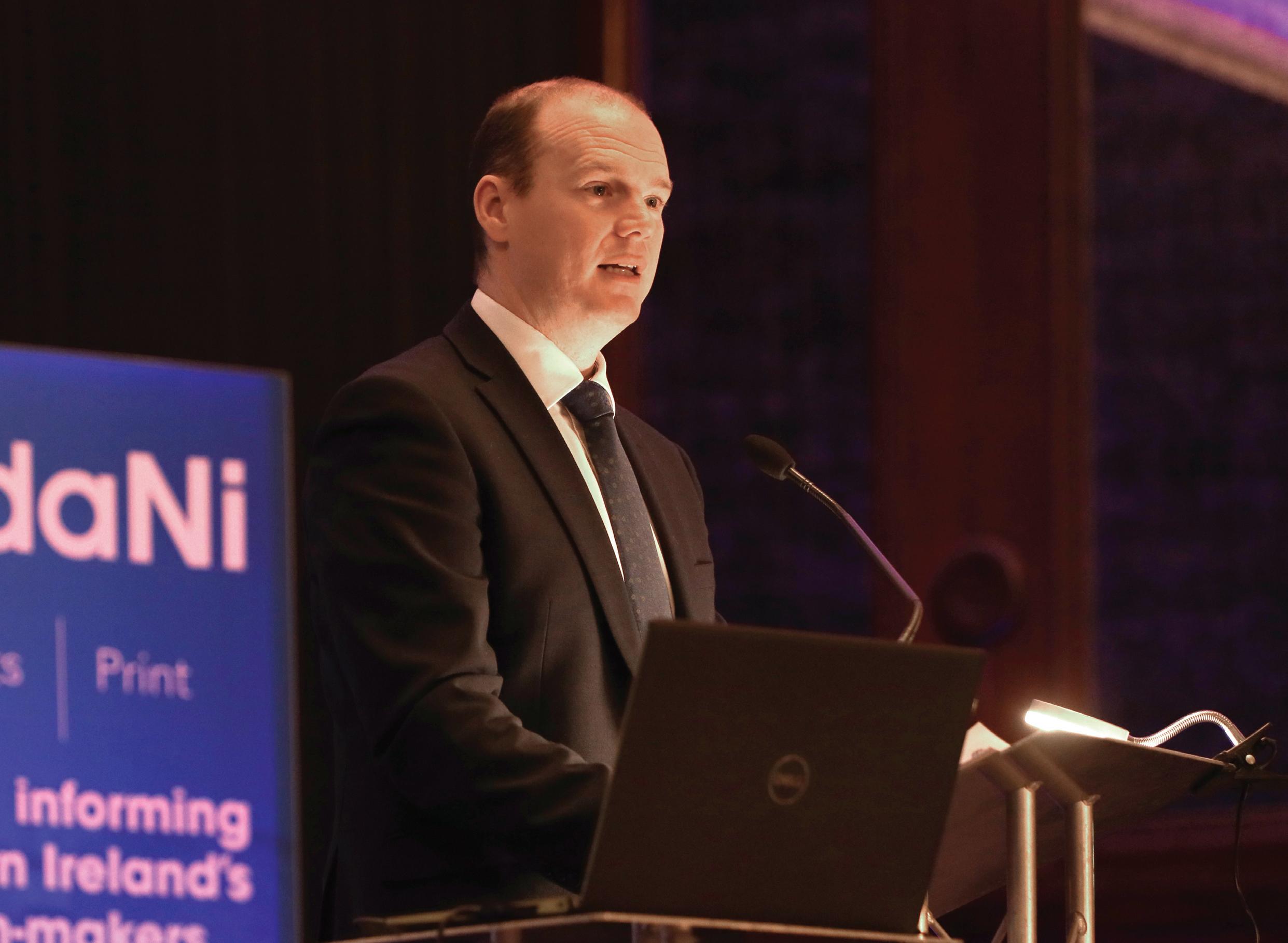

A decade on from the reforms to local government in Northern Ireland, Minister for Communities Gordon Lyons MLA sits down with agendaNi and discusses the evolution of the local government system.
Ten years on from the implementation of the Local Government Reform Programme, what is the continued significance of the new 11-council model?
As we mark the 10th anniversary, it is clear that many opportunities have been grasped, but challenges remain. The transfer of planning responsibilities and the introduction of Community Planning has brought decision-making closer to local communities, ensuring services are tailored to meet specific needs.
My department recently published a report – Impact of Local Government Reform on Service Delivery. This report confirmed that the reform process has brought about many positive changes and acknowledged areas for improvement and efficiency.
Councils have also driven economic regeneration by partnering with businesses, investing in infrastructure, and promoting tourism. Initiatives like labour market partnerships and the investment in City and Growth deals are creating jobs, boosting entrepreneurship, and enhancing connectivity.
How have Northern Ireland’s 11 councils demonstrated an ability to innovate and collaborate in the delivery of critical public services?
The reform has provided councils with the opportunity to explore new ways of delivering services. Many councils have embraced technology and digital solutions to improve service delivery and engage with their communities. For example – the use of digital platforms

and virtual tours has expanded access to cultural, heritage, and tourism experiences, allowing residents and visitors to explore and learn about the community's history and attractions.
Overall, the use of digital technology has resulted in greater accessibility, transparency, and citizen participation in local government decision-making processes and service delivery.
Community planning partnerships have also been instrumental in promoting joint working between local government, central government, community organisations, and other stakeholders. The value of effective community planning and partnership working was particularly evident during the Covid-19 pandemic. Additional funding was allocated through the Community Support Programme for community-led initiatives and to assist those who needed our help the most.

My department worked in partnership with central and local government to develop and deliver Covid recovery regeneration programmes with a total investment of almost £50 million to support our towns, cities and villages to recover from the impact of the pandemic.
Shared services have been established in various areas, such as home safety, tobacco, infectious disease, and air quality monitoring. These shared services help leverage funding from external stakeholders and promote quality and productivity.
Tourism is another important aspect of local government collaboration. Tourism NI works with all councils to achieve economies of scale in tourism and marketing efforts. By pooling resources and expertise, councils can attract more visitors, generate economic growth, and enhance the tourism experience in the region. We had enormous success with this in recent years, with tourist attractions such as The Irish Open at Royal County Down, the food and cider weekend in Armagh, the Halloween festival in Londonderry, The Giant Adventures in the Mournes and the Stairway to Heaven in Fermanagh. The Open in Royal Portrush in 2019 was also a huge success and is returning again later this year.
Councils also came together on several initiatives and programs, such as the Go for It Programme, Belfast Region City Deal, Digital Voucher Scheme, Levelling up Fund, and the development of the Support Hub.
Between 2017 and 2024 my department, in partnership with DAERA and local councils, delivered an Access and Inclusion capital programme aimed at improving access to a range of culture arts and active recreation venues, with over £5.5 million invested in approximately 300 projects.
Local government also plays a key role in civil contingencies as was the case during the recovery phase from Storm Éowyn. I worked closely with my local government colleagues to activate the Scheme of Emergency Financial Assistance to ensure immediate, onthe-ground support to the people affected. Each council played a leading role by setting up community assistance centres within their areas and working closely with the voluntary and community sector to provide
“We can achieve so much more when we work well together to create thriving communities and places where people want to live, work and invest.”
urgent support for those most in need. This was a real team effort and a good example of what can be achieved when we work together.
How has the relationship between local government and the Executive evolved since the reform?
I believe that, if we are going to realise the ambition of the Executive’s Programme for Government, local government will be key in helping us deliver successful outcomes for our citizens. Relationships between central and local government have been further strengthened through the establishment of the Partnership Panel (the panel) which I chair.
The panel meets twice a year and is comprised of the Executive ministers, NILGA representatives, and councillors representing all 11 local councils. The Panel considers areas of mutual interest, explores opportunities for innovative working and joint policy formation.
At official level, this is further enhanced through the Permanent Secretaries’ Group (PSG) and the Society of Local Government Chief Executives (SOLACE) Engagement Forum. This forum is another mechanism through which central and local government are working together. We can achieve so much more when we work well together to create thriving communities and places where people want to live, work, and invest.
Have there been any quantifiable improvements in service delivery or cost effectiveness as a direct result of the reform?
Yes, research by my department identified £21.5 million of efficiency
savings across the 11 councils. The actual amount is more as the research only covered the seven-year period up to 31 March 2022. As councils continue to work through the change agenda, many more benefits and efficiencies are projected to be achieved in the future, and I believe there is scope for further savings to be made.
Of course, since 2014, councils have a statutory responsibility to make arrangements for, and to report on, continuous improvement in their functions or services. These performance improvement plans are published on councils’ websites and actively seek input from service users to identify areas for improvement and ensure that services meet the needs of the community. The Local Government Auditor then assesses councils’ achievements against targets set in the plans.
Economies of scale have been achieved in various aspects of council activity, such as waste management, procurement, and contract management.
What have been the most significant challenges faced by local government in adapting to an enhanced role and remit?
As is normal when large organisations merge, councils faced many challenges, mainly within the areas of human resources and finance. The challenges presented by issues such as capacity, disparities in terms and conditions for employees, difficulties in integrating different working practices, and challenging budgets for transferred functions should not be underestimated either.
Councils still wrestle with many of these issues, however, overall, I believe that

“People are at the heart of all that we do, and we need to win hearts and minds if we are to achieve our ambition of creating thriving communities and places where people want to live, work, and invest.”
reform has brought transformation to local government. It is well-positioned to meet the needs of communities and drive the region’s future growth and development.
What transferable lessons from the reform process can be used to inform future structural change management at local or central government level?
As with any change management process, by sharing lessons learnt we can help inform and improve future structural change. People are at the heart of all that we do, and we need to win hearts and minds if we are to achieve our ambition of creating thriving communities and places where people want to live, work, and invest. We still have much to learn from this process and we will continue to monitor the progress of councils as they transition.
How has direct collaboration between the Executive/British Government and individual councils through City and Growth deals impacted the policy landscape?
There are four City and Growth deals across Northern Ireland that cover all of the 11 council areas. Each of the deals contain both Executive and UK Government funding. This will result in a total of £1.2 billion in central government funding over the next decade or so, representing one of the largest schemes of investment in history for local government. This investment will support the creation of up to 20,000 jobs, deliver a transformative digital innovation programme, improve connections through investment in infrastructure and create world-class visitor attractions which will regenerate towns and cities across Northern Ireland.
While the governance and delivery arrangements were challenging to begin with, my department played a leading role by working with partners across the Executive and in local government. We can learn a lot from how we are working together on City and Growth Deal delivery. This partnership has resulted in sharing of best practice, improved outcomes, and a more joined up approach between central and local government.
To what extent has local government demonstrated its potential to deliver in relation to change and economy growth?
The establishment of the 11 new councils in 2015 was not only an enormous organisational change involving, work-force mergers, physical relocation, new elections, and new processes etc., but it was also a significant cultural change, as councils stepped up to take on their new powers which included planning, community development, local tourism, and economic development. It gave councils more responsibility to ensure that, quite rightly, more decisions and services were tailored to better meet local needs.
It has empowered local government to drive economic development and job creation through initiatives such as business support programs, investment incentives, and partnerships with local businesses and educational institutions. This has resulted in increased investment, growth in key sectors, and the attraction of new businesses to the region.
My department worked closely with local government partners to establish Labour Market Partnerships (LMPs) since 2020/21 across all 11 council areas. This is an excellent example of how a multi-agency, collaborative approach involving local experts and practitioners can improve employability outcomes and labour market conditions. LMPs focus on evidenced priorities and interventions appropriate to their
individual area, and can change the scope of their delivery to meet the changing needs of the labour market. LMPs are designed to avoid duplication, and interventions are planned around filling any gaps in existing local labour market provision or providing additionality.
From 2021/22 to 2023/24 LMPs achieved a 70 per cent completion rate for provision delivery, supporting almost 3,000 people into employment or self-employment. LMPs have also helped those in work to increase their hours or earnings while also enabling over 3,000 local citizens to gain a new qualification.
In 2018, the House of Commons’ Northern Ireland Affairs Committee recommended that an independent review of local government powers and finances be undertaken. What opportunities are there for further local government empowerment/enhanced devolution of powers in the years ahead?
In the Programme for Government (PfG): Our Plan: Doing What Matters Most, the Executive has committed to working together to deliver nine priorities with the goal of improving the wellbeing of everyone living and working here. Local government played a key role in the PfG consultation process and will be a delivery partner on many of the outcomes.
Housing supply and ensuring the delivery of good quality, affordable, and sustainable homes is one of my top priorities. Last December [2024], I secured Executive approval for my Housing Supply Strategy and agreed with Executive colleagues to include ‘Provide More Social, Affordable and Sustainable Housing’ as one of the nine priorities in the PfG. The Housing Supply Strategy sets out a clear framework for a whole system approach to delivering the supply of homes we need over the next 15 years. Local government was directly involved in the process to develop the Strategy and will continue to play a key role going forward by ensuring there is an effective and efficient planning system in place that can help meet these ambitions. This includes the delivery of Local Development Plans (LDPs), which establish the zonings and policies to ensure spatial growth requirements of local areas can be met. My department continues to support local council planning teams sharing knowledge and information to ensure we maximise the opportunities for increasing housing supply through the LDP process.
The Landlord Registration Scheme is another example of councils taking on additional responsibility for delivery of services. The scheme transferred to councils on 1 March 2025, with Lisburn and Castlereagh City Council (LCCC) acting as lead council on behalf of all 11 councils. The benefits include more joined up work in the private rented sector; additional evidence/tools to support enforcement activity and consistency in management of the private rented sector.


“Housing supply and ensuring the delivery of good quality, affordable and sustainable homes is one of my top priorities.”
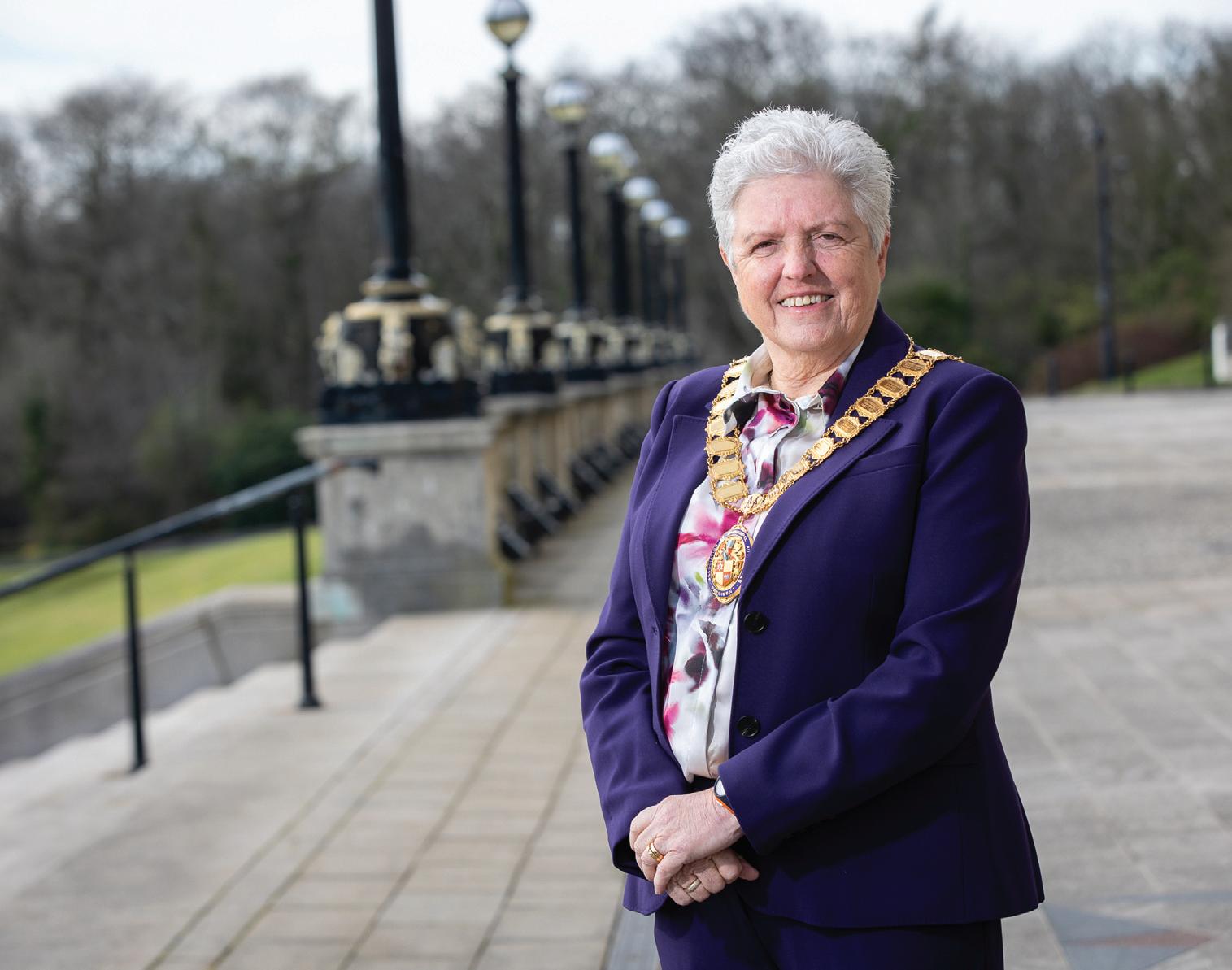
Local government reform in Northern Ireland has undergone a significant transformation over the past decade. The changes have sought to enhance the efficiency, transparency, and accountability of our local councils, empowering them to deliver better services and drive economic and social development.
Central to this transformation has been the evolving role of councillors, who have become pivotal in implementing reforms and advocating for their communities.
Reflecting on the past 10 years provides insights into the successes achieved, opportunities taken, and the pathways for future growth and development.
The most significant milestone in recent local government history was the 2015 restructuring and reform of the sector. This reduced the number of councils in Northern Ireland from 26 to 11 and the number of councillors from 582 to 462.
This reorganisation aimed to streamline local governance, reduce duplication of efforts, and achieve economies of scale. The reforms also provided
councils with enhanced powers, including planning, community development, and economic regeneration. The devolution of these responsibilities brought decision-making closer to local communities, ensuring council services were tailored to their specific needs.
The introduction of the Local Government Act (Northern Ireland) 2014 formalised many of these changes, emphasising the importance of robust governance, long-term financial planning, and community engagement. The Act also laid the foundation for the adoption of community planning, which required councils to collaborate with statutory bodies, the private sector, and community organisations to deliver strategic development plans.
Over the past decade, councillors have become central to local governance in Northern Ireland. Their role has evolved from one focused primarily on service delivery oversight to one encompassing strategic leadership, community engagement, and partnership building.
1. Strategic leadership: With the transfer of planning powers and the introduction of Community Planning, councillors have had to adopt a more strategic approach. They play a key role in setting longterm priorities, ensuring alignment with regional development strategies, and addressing crosscutting issues like economic inequality, housing, and climate change.
2. Community advocacy: Councillors serve as the bridge between the council and local communities, advocating for constituents’ needs and ensuring their voices are represented in decision-making. This requires a deep understanding of local challenges and opportunities.
3. Partnership building: Successful governance in a post-reform environment requires collaboration. Councillors have had to collaborate closely with statutory partners, businesses, and community organisations to develop and implement effective policies.
The reform agenda has delivered several notable successes, highlighting the potential of streamlined and empowered local governance.
1. Improved efficiency and financial management: The reduction in the number of councils has led to savings. Councils have also adopted modern financial planning tools, ensuring better resource allocation to support long-term sustainability.
2. Enhanced service delivery: By bringing decision-making closer to communities, councils have been able to design services that better reflect local needs. The transfer of planning powers has allowed for greater community input and consideration.
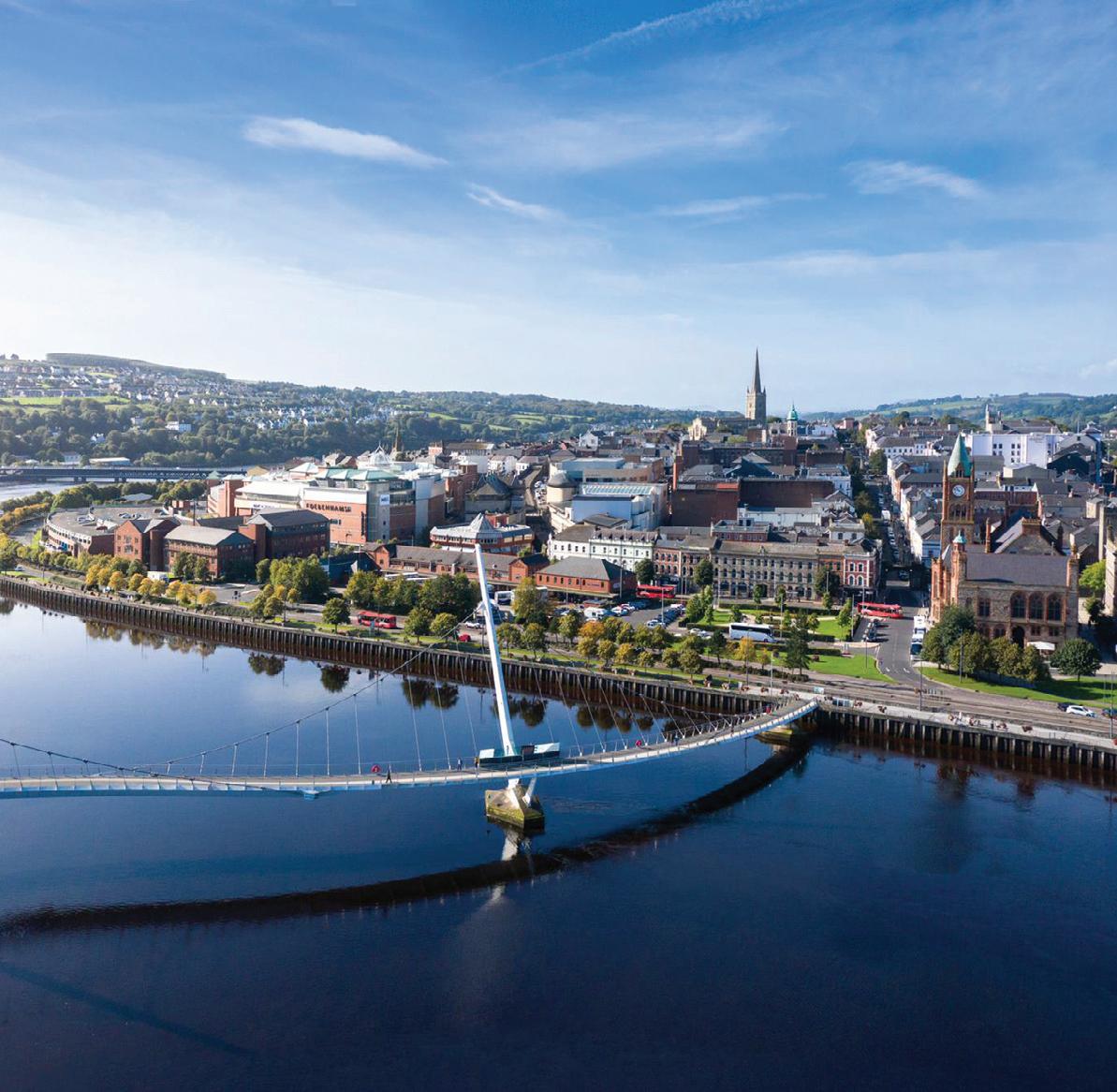
3. Community planning frameworks: Councils have made strides in implementing Community Planning, fostering greater collaboration across sectors. These plans have addressed key local priorities, such as health and well-being, economic growth, and environmental sustainability.
4. Economic development initiatives: Many councils have successfully spearheaded initiatives to attract investment, support local businesses, and create jobs. These include urban regeneration projects, rural development programs, and efforts to boost tourism.
1. Citizen engagement: Councils have increasingly used digital tools and platforms to engage with residents, ensuring greater transparency and public participation in decision-making. The development of digital engagement tools allowed councils to pivot their engagement with the public to online and digital channels during the Covid–19 pandemic, enabling councils to maintain communications and services.
2. Local identity: By emphasising the unique strengths of their areas, councils have leveraged local
identity to boost tourism and attract investment.
3. Environmental sustainability: Councils have played a key role in helping to address environmental challenges, including waste management, energy efficiency, and biodiversity protection. Projects such as renewable energy schemes and green infrastructure developments have been initiated.
Looking ahead, Northern Ireland’s local government face many opportunities to build on the foundations of the past decade.
1. Devolution of powers: Properly funded and resourced, there is potential for additional powers to be transferred to councils, particularly in areas like housing, transport, and education.
2. Digital transformation: Councils can expand their use of technology to improve service delivery, enhance citizen engagement, and drive innovation.
3. Climate action leadership: Local governments are well-placed to lead the transition to a low-carbon economy. By implementing ambitious climate action plans, councils can reduce emissions,
create green jobs, and enhance community resilience.
4. Strengthening community partnerships: Councils can deepen their collaboration with community and voluntary organisations to address social challenges, such as poverty, mental health, and social isolation.
5. Collaboration: Northern Ireland’s councils have opportunities to collaborate with counterparts in England, Scotland, Wales, and the Republic of Ireland. Such partnerships can support regional prosperity, learning and environmental efforts.
Despite these opportunities, there are challenges that councils must navigate. Financial pressures and public expectations for improved services are ongoing concerns. Additionally, achieving meaningful citizen participation and balancing competing priorities require continuous effort and innovation.
The reform of local government in Northern Ireland over the past decade has laid the groundwork for more efficient, responsive, and dynamic councils. Councillors have played a critical role in driving this transformation, demonstrating leadership, fostering collaboration, and advocating for their communities.
While significant successes have been achieved, the journey of reform is ongoing. By embracing new opportunities and addressing emerging challenges, our member councils can continue to strengthen their impact, delivering tangible benefits for our constituents and contribute to the region’s long-term prosperity.
T: 44(0)28 9079 8972
W: www.nilga.org
X: @NI_LGA
LinkedIn: Northern Ireland Local Government Association
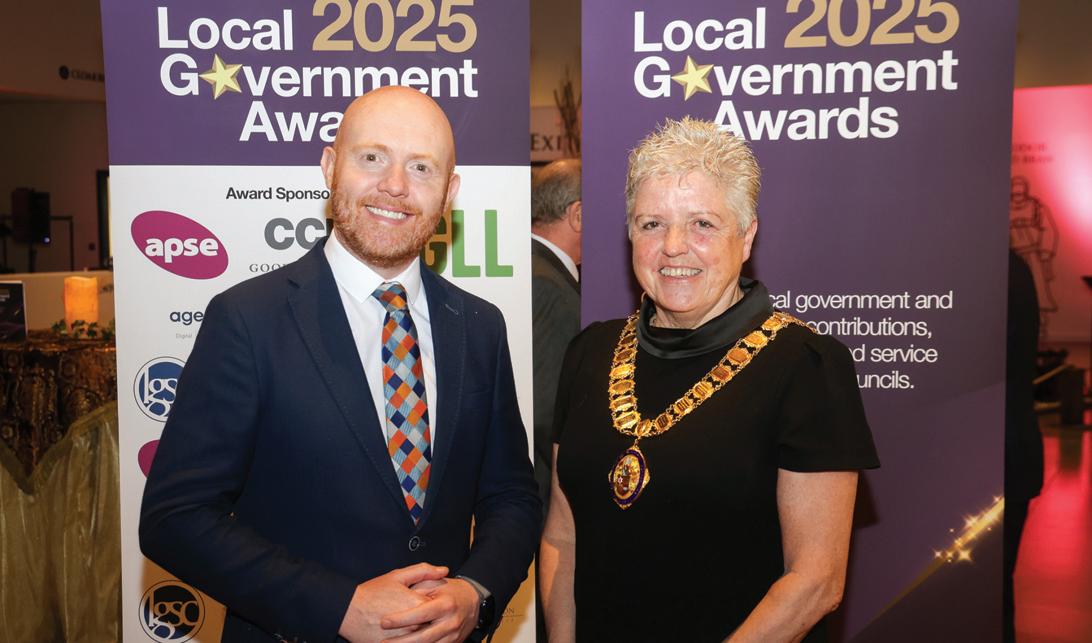
Local Government Awards host, Barra Best and Cllr Alison

Local Government Awards sponsors and partners (l-r) Robert Gilmore (WJMT), Daniel McGlade (GLL), Stephanie Singer (Quadra Consulting), Sarah Owens (GLL), Cara Marks (Hays), Gail Kinkead (agendaNi), Jonathan Carr West (LGiU), Bea Makeig (LGiU), Thomas Lynch (LGiU), Lee Jagger (CCLA), Matt Ellis (APSE), Sian Thornthwaite (SBRI), George Barton (APSE), Sharon McNicholl (LGSC) and Bumper Graham (LGSC).
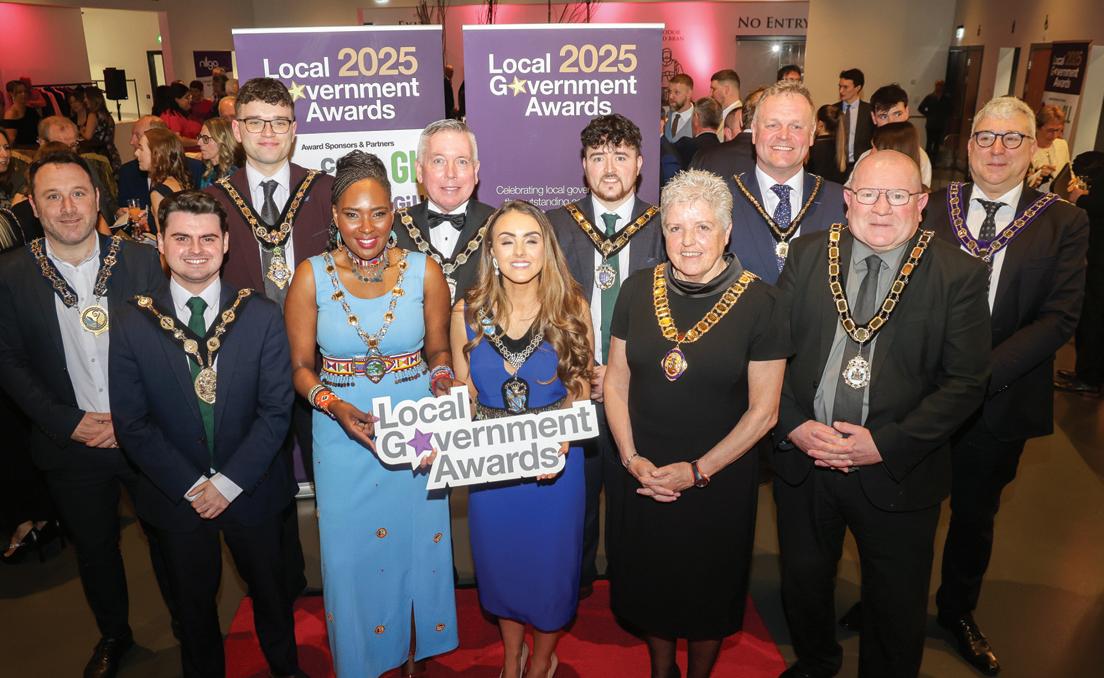
1. Best Outcome of the Past Decade Award Award partner LGiU Winner: Food Heartland Armagh City, Banbridge and Craigavon Borough Council
2. Service Innovation and Improvement Award
Award partner APSE
Winner: The Transformation and Modernisation into a UK Award Winning Leisure Service Antrim and Newtownabbey Borough Council
3. Best Use of Data and Technology Award Award partner SBRI
Winner: Bespoke CRM Digital Solution for Regional Enterprise Support Service Belfast City Council
4. Engaging Communities Award Award partner CCLA Good Investment Winner: Belfast 2024 Programme Belfast City Council
5. Collaborative Partnership Award Award partner Hays Recruitment
Winner: Mid Ulster Labour Market Partnership: Working Together to Improve Employability in Mid Ulster Mid Ulster District Council
6. Local Government Equality, Diversity, and Inclusion Award Award partner LGSC Winner: Autism Friendly Borough Initiative Mid and East Antrim Borough Council
7. Communications Campaign of the Year Award
Award partner agendaNi



8. Best Initiative by a Councillor Award Award partner NILGA
Winner: Cllr Cadogan Enright, Green Economy Newry, Mourne and Down District Council
9. Employee of the Year Award Award partner William Johnston Memorial Trust
Winner: Deirdre O’Connor, Anti-Poverty Officer Fermanagh and Omagh District Council
10. Innovative Planning for the Future Award Award partner Quadra Consulting Winner: ABC Place Plans Armagh City, Banbridge and Craigavon Borough Council
















Winner: Visit Causeway Coast and Glens Spring Campaign 2024 Causeway Coast and Glens Borough Council

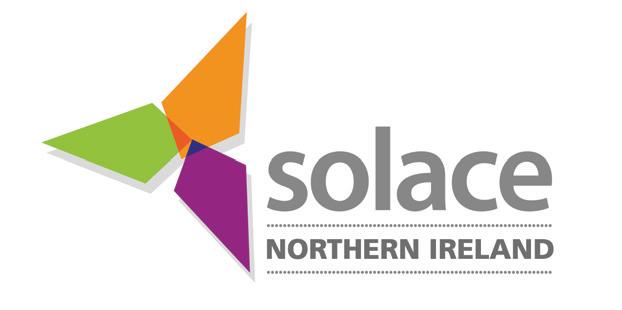


The Society of Local Authority Chief Executives (Solace) acts as the professional voice for local government across the UK, with branches in the English regions, Wales, Scotland, and Northern Ireland.
As members of the Solace Northern Ireland Branch, the chief executives of the 11 district councils lead the collective role of local government in in creating vibrant, safe and sustainable places, and transforming the lives of citizens.
Each chief executive has the opportunity to chair the Solace NI branch. In June 2025, Marie Ward, Chief Executive, Newry, Mourne and Down District Council, will come to the end of her tenure as Chair, and will hand over to Alison McCullagh, Chief Executive, Fermanagh and Omagh District Council. Through NILGA, Solace NI works closely with elected members to present a strong, collective voice for the local government sector in Northern Ireland.
Reflecting on the past 10 years, Ward acknowledges the extraordinary pace of change across the sector and pays tribute to the hard work, dedication and leadership of the local government team.
“Councils have led one of the biggest transformation programmes in Northern Ireland, and whilst there have been many challenges, we should be proud of our achievements. The 26 councils have successfully amalgamated into 11, are operating as planning authorities, and also delivering additional, new statutory functions including community planning, performance improvement, and local economic development,” Ward says.
Navigating the transformation journey of local government has not been straightforward, as the past decade also serves as a stark reminder to expect the unexpected. Whether it was the global pandemic, cost of living crisis, natural disasters, financial pressures and political instability, time and time again, councils rose to the challenge, with agility, foresight and courage, placing local communities at the heart of everything we do.
The way we work and our collective response to these unforeseen crises has strengthened the role of local government as the ‘glue’ within communities and across our stakeholder network, focused on finding the right solutions to help the most vulnerable in society.
With an appetite and willingness to continue transforming and improving, McCullagh is looking forward to the next 10 years of local government with confidence and ambition.
“Blending the learning of the past with our aspirations for the future, investing in our people, capitalising on our closeness to communities and operating as a connected and collaboratives sector will be instrumental in making the most of the challenges and opportunities as they arise,” says McCullagh.
Strong local leadership, creativity and experimentation will ultimately determine our success in addressing climate change, driving forward digital transformation, understanding the impact of artificial intelligence on public services, securing the financial sustainability of the sector, building sustainable places, addressing inequality and demonstrating resilience in the face of future crises. Coupled with exciting initiatives such as City and Growth Deals and Peace Plus, the power and potential of NILGA and Solace NI, working together to lead and empower a strong local government team, focused on making life better for our people and places across Northern Ireland, has never been more significant.
As a sector, we have demonstrated our ability to embrace change and transformation over the past decade, and there is no doubt that local government will continue to flex, innovate and make a real, sustainable and positive difference over the next decade.
W: www.solace.org.uk
Source: Department for Communities

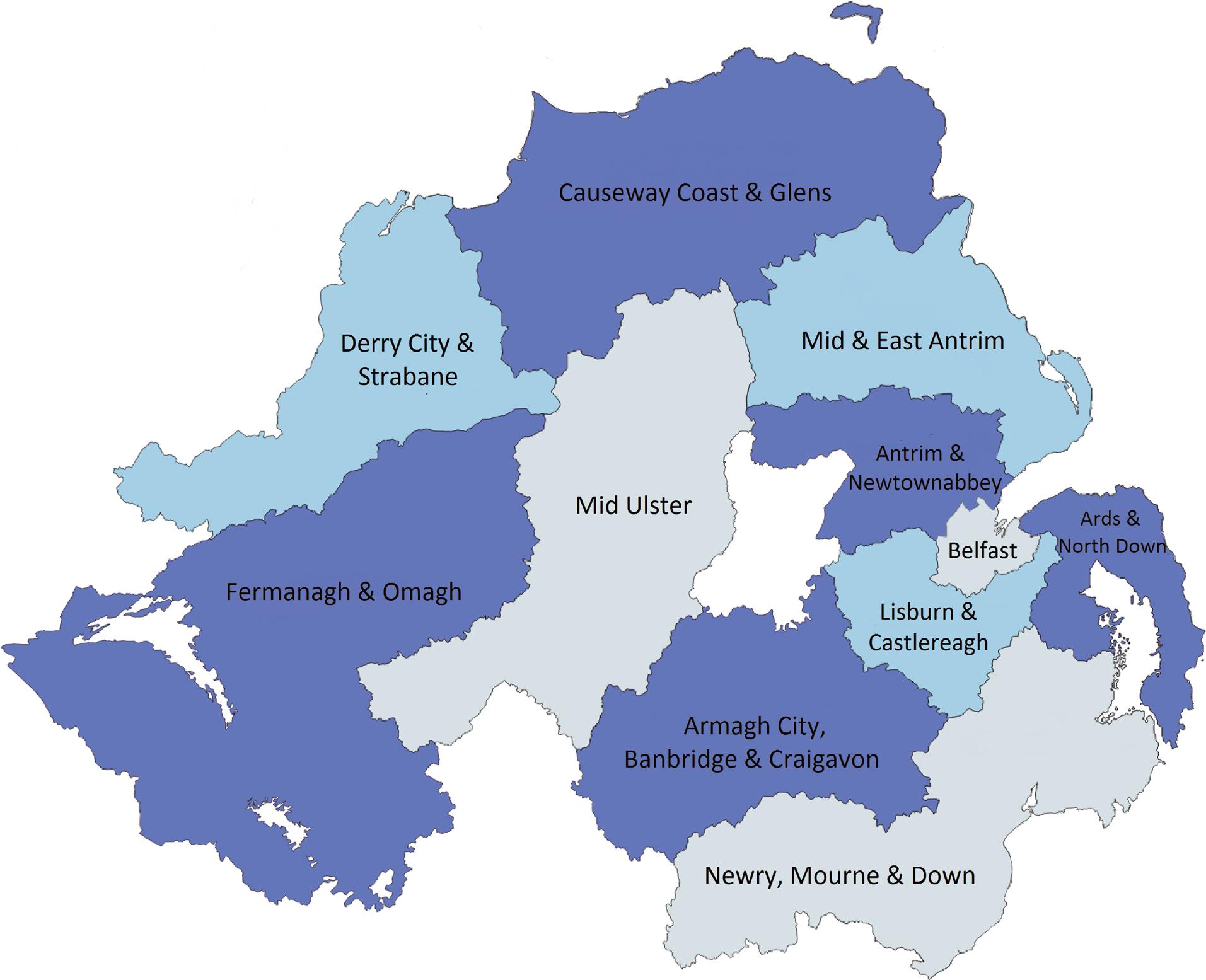
Three years after the Local Government Boundaries Commissioner submitted her final recommendations report, the Department for Communities has yet to publish it. Speaking to agendaNi, Minister for Communities Gordon Lyons MLA has confirmed that the report is still under consideration and will require Executive approval before any changes can be implemented.
When asked for an update on the publication of the final report, Minister Lyons told agendaNi in late March 2025: “That [the Local Government Boundary Review Recommendations] is being considered and it will require Executive approval for some of the changes that are being talked about. I expect that to be with the Executive very soon.”
However, no definitive timeline was provided on when the report will be made public or when legislative action will be taken.
The review process, completed in 2022, was intended to update and refine local government boundaries in Northern Ireland, ensuring they reflect population changes and community needs.

The Commissioner’s recommendations were submitted to the Department for Communities, whose role is to lay the final report before the Northern Ireland Assembly, “with or without modifications”.
The delay in implementing the review has already had electoral consequences. As a result of the time lag between the report’s submission and the last local government elections in May 2023, the Department confirmed that it would not enact any changes before that election.
As a result, council elections proceeded based on outdated ward boundaries, despite the Commissioner’s recommendations being available. This was by design, but remains a significant challenge given the continued delay in enacting the changes.
Meanwhile, new boundaries have been introduced for Northern Ireland’s parliamentary constituencies, and these were utilised in the Westminster election in July 2024. They will also be in effect for the next Northern Ireland Assembly election, which must take place by 2027. The next local elections are also scheduled for 2027 meaning time is running out to implement the recommended local government boundary changes before another election cycle begins.
One of the central themes of the review is the balance between electoral parity and community identity. A major point of contention has been the boundary between Belfast City and its neighbouring Lisburn and Castlereagh Districts.
Belfast City Council argued for an adjustment to align boundaries with clear geographic markers, such as the A55 outer ring road. However, the Commissioner ultimately determined that the existing boundary should remain, citing the importance of stability and minimal disruption.
Additionally, the review examined the structure of electoral wards within districts. The final report proposes adjustments in some areas to account for population growth and ensure that each councillor represents a roughly equal number of electors.
However, the review also recognises the limits imposed by legislation, which prioritises numerical balance over social and historical ties. Many respondents voiced concerns that rigid adherence to electoral balancing could disrupt well-established community links
During the consultation phase, 15 formal submissions were received in response to the revised recommendations. These submissions largely focused on localised concerns regarding specific boundaries. Some councils and community groups argued for modifications that would better reflect natural communities, rather than purely numerical calculations.
For example, the challenge of determining the boundary between Mid and East Antrim and Causeway Coast and Glens was raised. Some residents expressed dissatisfaction with the current division, arguing that it does not accurately reflect local affiliations. However, the Commissioner ultimately decided against making changes, citing a lack of compelling evidence for a realignment.


The last 10 years have seen a period of considerable change for the better in Belfast. Local government reform in 2015 saw councils assume a greater leadership responsibility for a range of additional strategic and delivery areas.
Enhanced responsibilities – including planning; economic development; and community planning – have allowed Belfast City Council to really drive the city’s economic growth and prosperity and indeed that of the wider region.
Through building strategic alliances and focussing on attracting additional resources to provide quality services, the council has been helping to shape the city’s future.
Belfast was not subject to the same level of geographic changes which many other councils experienced a decade ago. There were some minor boundary changes, and a population increase – but more significantly there was an increased ambition to focus on city leadership to build strong partnerships, to address key city challenges, and to maximise opportunities.
This manifested itself in a commitment to sustainable, inclusive growth – a cornerstone commitment of the Belfast Agenda, which was initially launched in 2017 and refreshed last year.
The Belfast Agenda sets out the guiding principles for the development of the city. It provides a framework for inclusive economic growth. This focus is complemented by four other key strategic themes – our people and communities; our place; our planet; and creating a compassionate city.
The city is now a global innovation hub, a knowledge-based economy, and home to high growth sectors such as advanced manufacturing, creative industries, fintech, life and health sciences cybersecurity and film production. These sectors help drive economic growth not just in Belfast itself but in the wider city region, and indeed right across Northern Ireland.
The numbers tell their own story. Since 2012, there has been a net increase of more than 30,000 jobs in Belfast – about a quarter of all jobs created in Northern Ireland over that period. The average annual economic growth rate in Belfast between 2012 and 2022 was 5 per cent. Belfast’s economy has grown by £6.4 billion – or 58 per cent – over the last decade, while the city has a low unemployment rate of 2.4 per cent.
And with one in seven businesses in Northern Ireland based in Belfast, the importance of the city to Northern Ireland’s economic health is clear to see. There is more to do to continue to realise the ambition and commitment of making Belfast a great place to live and work.
We have seen the benefit that extensive devolution agreements have had for cities such as Manchester and Liverpool, with greater control over transport, housing and skills development. These powers have been used to drive infrastructure investment, Manchester has become an internationally renowned hub for innovation and business growth and Liverpool has used its maritime strength and cultural economy to great effect and is now one of the UK’s fastest growing cities. These assets exist in abundance in Belfast, and Belfast City Council is well placed to work in partnership with local anchor institutions to unlock the economic potential of the Belfast City Region.
It is well established that, globally, cities drive economic growth accounting 80 per cent of GDP and close to 90 per cent of job creation. As the capital and largest city in Northern Ireland, Belfast plays a central role in driving economic growth across the region. Belfast acts as a net job creator for all adjacent areas. Almost half of those who work in Belfast do not live in the city and this is indicative of the city’s role as an employment hub for Northern Ireland, attracting a high proportion of commuters into the city for work.

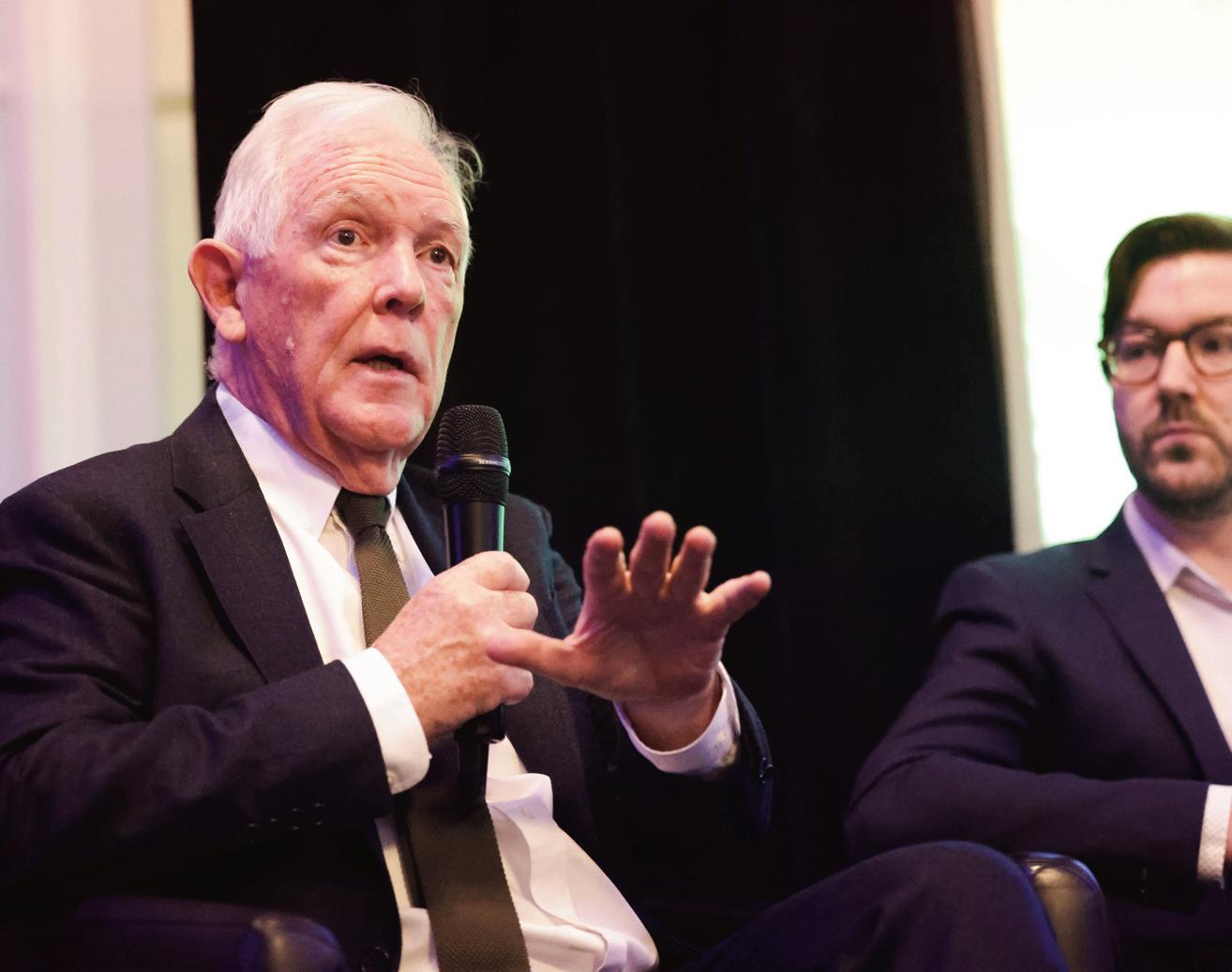
However, challenges remain and while Belfast supports proportionately more higher-level jobs than other areas, it also has a disproportionate level of deprivation in many neighbourhoods. This apparent contradiction is behind the council’s commitment to focus on supporting sustainable and inclusive growth in Belfast – capitalising on the assets and the investments that have made Belfast a global business destination while ensuring that our residents have an opportunity to benefit from and contribute to that growth.
People are our most important assets and the council’s commitment to inclusive growth is demonstrated through interventions such as our Belfast Employment Academies – creating skills pathways to support those furthest from the labour market to move into well-paid roles in key growth sectors. We also want to inspire and support entrepreneurs to reach their full potential through the Go Succeed service – which offers a flexible menu of support for new and existing businesses, with a specific focus on under-represented groups.
And with a healthy development pipeline, we want to ensure that we focus on deriving maximum benefits from those capital projects for the people of Belfast. One critical element of this work is the programme of investment generated through the Belfast Region City Deal (BRCD). Signed in December 2021, this represents a new way of working
between central and local government and regional partners. It secured a bespoke package of investment from central government and the BRCD partners of more than £850 million.
It aims to support the inclusive economic growth that delivers more and better jobs, a positive impact on the most deprived communities and a balanced spread of benefits across the region.
A huge undertaking, the Deal is coordinated by a team in Belfast City Council and is an exemplar of partnership working. It has already strengthened the region’s offer in growth sectors such as life and health sciences, the digital and creative industries, and advanced manufacturing.
With a goal of creating 20,000 new jobs, the deal will support next generation digital capabilities, boost tourism and support the region’s regeneration.
The most advanced projects are now recruiting and upskilling staff, constructing new premises, co-designing projects with industry, procuring next generation technology and equipment, and moving fully into operation.
The council’s £105 million leisure transformation programme which has also successfully delivered cutting-edge facilities, with unique selling points to attract users from across the city such as Andersonstown, Olympia, Lisnasharragh, and the refurbished historic Templemore Baths – which won



a heritage project RICS award. These investments have resulted in increased memberships and usage of the centres with the aim of increasing the wellbeing of our citizens.
And there are big plans afoot for other key sites. Giant’s Park –a £100 million public-private project which will see an adventure park and nature reserve created on the vast former landfill site on the North Foreshore.
Belfast Stories will be another landmark project for the city. Expected to open by 2030, the visitor attraction, public space and creative hub at the much-loved Art Deco former Bank of Ireland building and the surrounding 5,000 square metre site will aim to attract more than 700,000 visitors per year, with up to 1,200 jobs supported during the construction and launch phases. It will help drive regeneration of the north side of the city centre.
Indeed, the redevelopment and revitalisation of Belfast’s city centre are key priorities for the council.
The 10-year anniversary of local government reform coincides with the 10-year anniversary of Belfast City Council’s strategy to improve the city centre – Belfast City Centre Regeneration and Investment Strategy (BCCRIS).
Globally recognised expert in city place-making and regeneration and Urban Strategies Inc partner, Joe Berridge helped shape BCCRIS. Returning to the city almost a decade later, he was impressed by the progress made in that space of time – especially given the aftereffects of the Covid-19 pandemic.
“The city centre is in far better health. There has been significant development and regeneration activity across a number of sectors, including office, hospitality, hotel and tourism and purpose-built student accommodation. The retail sector continues to show remarkable resilience despite challenges,” he said.
“I noted during my recent visit a sense of vibrancy and positivity in the city centre. Footfall is up, and the impact of the Ulster University’s campus relocation and students in the city has been transformative, bringing vitality and activity to the city centre.
“High quality shops and restaurants have become an increasingly attractive feature, contributing to an urban environment that is welcoming of investment and activity.”
There has been a significant level of development and regeneration activity delivered by the private and third sector across a range of building classes, particularly in the areas of provision for offices, tourism and hospitality, student accommodation and retail. Strong, vibrant communities that border the city centre have played, and should continue to play, a key role in the city centre’s regeneration.
By early 2024, over 5,000 student beds had been completed (with more than 1,000 beds under construction).
Students are an important source of city centre housing demand not only whilst studying, but after they graduate, commence their careers and consider making Belfast their home.
The goal of achieving more city centre living capacity received a massive boost in November 2024 when Belfast City Council selected GRAHAM as its longterm private sector partner to work alongside the council to deliver residential-led, mixed-use, sustainable developments across multiple sites.
With an overall development potential of around £630 million, this initial partnership phase leverages strategic council-owned city centre sites with a development value of £280 million, which will deliver mixed tenure homes to help meet the needs of those wishing to live in the city.
This innovative approach will help drive forward city centre living and housingled regeneration across the city.
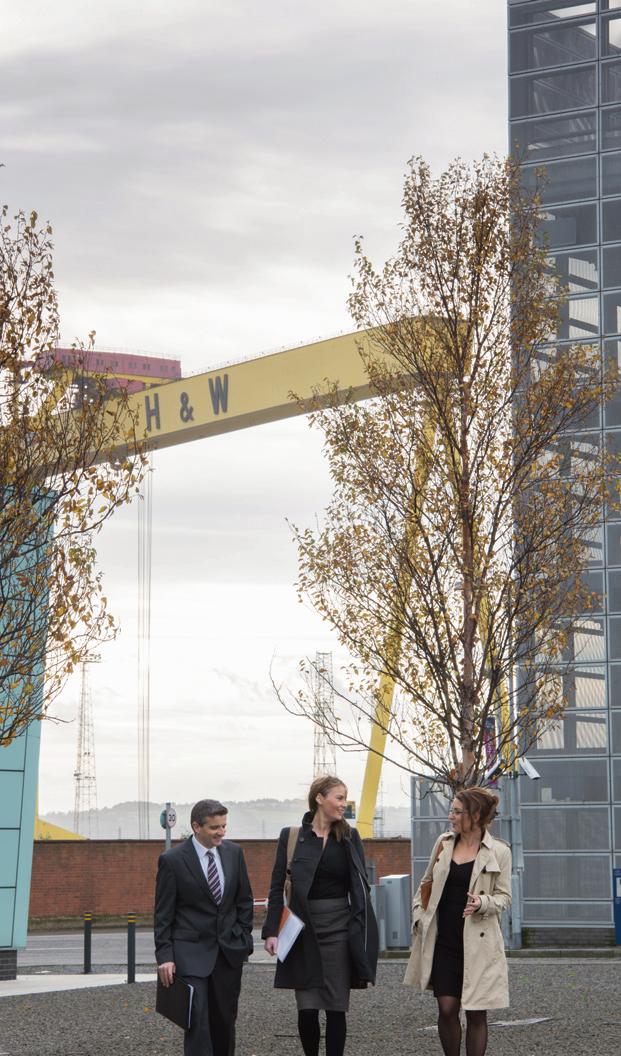
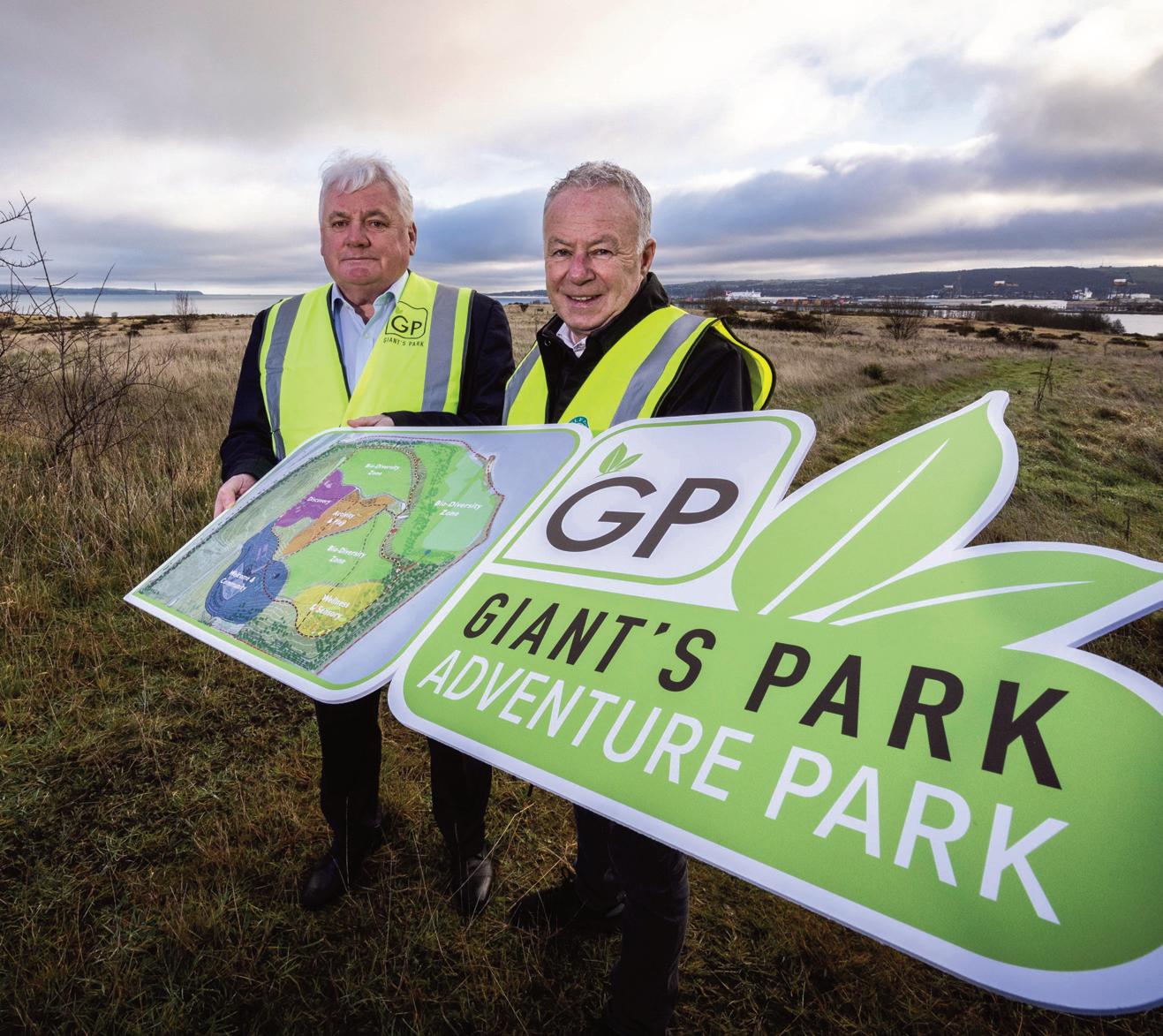
The city’s tourist and cultural offering has also evolved greatly over the 10 years since local government reform. Belfast became a UNESCO City of Music in 2021, the only one to date on the island of Ireland, and will host the globe’s largest celebration of Irish traditional music and culture – the All-Ireland Fleadh – in 2026. The Fleadh will attract at least 700,000 visitors from right across the globe to the city. And Belfast is now well equipped to cater for such an influx with its superb hospitality offer. Since 2015, Belfast has been rated as the number one region to visit by Lonely Planet in 2018 and more recently featured in the second spot in National Geographic Traveller Magazine’s ‘Cool List 2024’.
But the job of building a better Belfast is by no means finished. While we mark 10 years since local government reform and can be proud of the positive change in the city and the Belfast region in that time, it is worth remembering that there
are another 10 years in the Belfast Agenda’s lifespan. Targets for 2035 include growing the city’s population by more than 60,000, enhancing options for city centre living in a clean, green and connected place and innovating towards net zero emissions.
To deliver these goals, Belfast must continue its journey of inclusive growth, remain competitive on the global stage for inward investment and drive economic development for the wider region.
And it is clear that key to success is confident leadership, combined with effective partnership working.
www.belfastcity.gov.uk
X: @belfastcc
Facebook: @belfastcitycouncil
Instagram: @belfastcitycouncil
LinkedIn: ‘Belfast City Council’



The reform of local councils 10 years ago improved service delivery but cost effectiveness cannot be comprehensively assessed due to a limited study timeframe and a lack of information, a report by the Department for Communities (DfC) indicates.
In a November 2024 report – Impact of local government reform on service delivery and cost effectiveness – DfC states that annual costs in local councils increased in the seven-year period after reforms but the report indicates that inflation, the transfer of functions from Executive departments to local government, and investment in capital infrastructure contributed to this increase.
For 2012–2015, the combined average income of the councils stood at £952 million. This figure rose by 4.7 per cent to £997 million for 2015–2022. Average expenditure for 2012–2015 equalled £966 million and rose by 7.5 per cent to £1.04 billion for 2015–2022. In the seven-year period after reform, local authorities’ spending deficit equalled £286 million, an average of £40.8 million per year. Councils used their reserves and borrowed funds, “mostly from central government”, to address the deficit, the report states.
In the five years before reform, capital investment by councils averaged £99 million, and this figure climbed to an average of £119 million for 2015–2022. The report notes that this figure stood at £128 million for 2015–2020, before budgets were impacted by Covid-19-enforced lockdowns.
The report claims that during the study period, local authorities made £21.5 million in efficiency savings – savings made without cutting services. Local authorities also identified future investment opportunities worth £1 billion due to their “enhanced scope of powers”.
The following responsibilities were transferred from executive departments to local authorities under reforms:
• planning;
• off-street car parks;
• urban regeneration and community development;
• housing;
• local economic development; and
• local tourism.
Overall, the DfC report finds that councils were able to improve services while cutting costs due to greater collaboration between councils, and economies of scale created by amalgamated councils. However, it also identifies challenges including budgetary shortfall from central government to deliver new functions and responsibilities.
Transferring planning duties to local government gave residents a “voice in decision-making” and local councillors’ had a more in-depth understanding of their districts than central government. This enabled more sustainable development in communities, according to the report. Increased collaboration between councils also led to more “consistency and efficiency” in planning decisions, the report claims.
Increased collaboration between councils facilitated the procurement of better contracts. The report says local government pooled resources together to leverage more competitive contracts for waste management, electricity, gas, and fuel. It also enhanced their ability to attract investment and acquire funding from DfC and Invest NI among others.
During the study period, local government invested in various sectors, including IT infrastructure, and the construction and renovation of public spaces, parks, and leisure facilities. Councils also invested in measures to reduce environmental impact, including cycling infrastructure, electric vehicle charging points, solar panels, geothermal heating and cooling systems, energy-efficient lighting, and smart building systems.
Reforms enabled local government to “undertake large scale strategic capital and regeneration projects which require a multi partner approach from a financial and logistical/delivery approach”, according to the report.
It outlines various measures local government took to improve existing systems following reform. Approval layers were removed, clear guidelines were established to streamline decision-making processes, and asset management systems were implemented to enable regular inspections, proactive maintenance, and asset lifecycle planning.
During the study period, councils formed partnerships with local businesses while providing support programmes and investment incentives. The report claims this has increased investment, attracted new businesses to districts, and upskilled employees.
Transferred functions also presented challenges to local government as

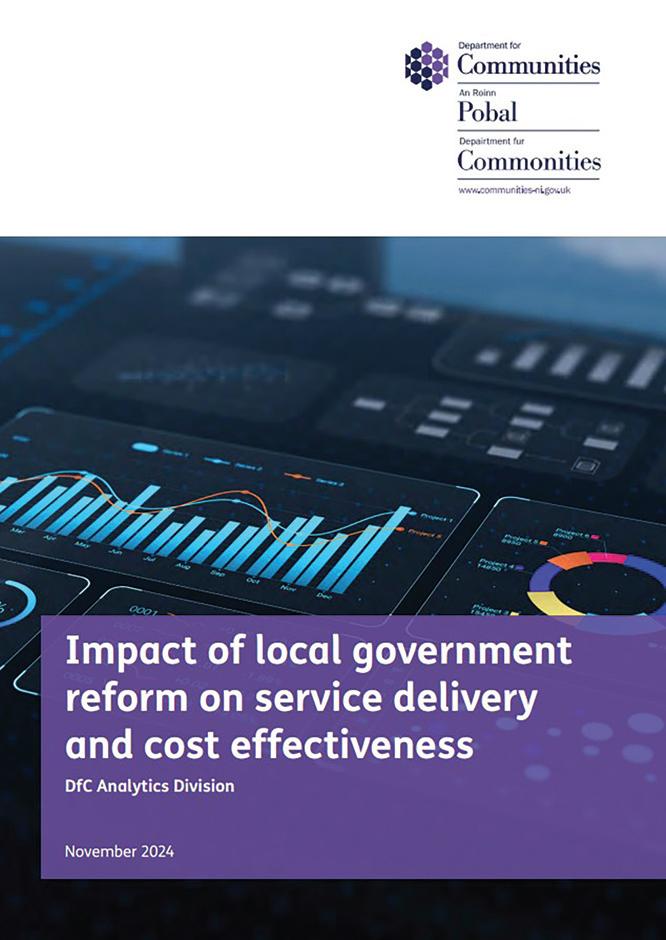


councils had to deliver additional duties without additional budgeting from central government. The report states that this “limited councils’ ability to deliver against expectations and meet the needs of the community”.
Amalgamating 26 councils into 11 also posed challenges including the duplication of roles in the initial stages of reform which dented staff morale and impacted efficiency. The report states that staff were reassigned, and a severance scheme was introduced to address this. Constituent parts of the newly formed councils had differing procedures and processes which was addressed through the implementation of standardised procedures.
The report notes that councils faced “political uncertainty” in the years after reform as the Assembly dissolved in January 2017 and did not reform until January 2020. It also highlights that Covid-19 public health lockdowns impacted service delivery.
The report claims: “A number of councils faced difficulties in engaging with central government during the collapse of the Executive. This created challenges in delivering community planning without a detailed programme for government and clear guidance.”
It is noteworthy that the report identifies collaboration between amalgamated councils as the greatest benefit from reforms, while also highlighting a lack of
support from central government as one of the key challenges faced. Elected members and staff faced upheaval under reforms while they were tasked with delivering additional services without additional support. External pressures such as the Executive’s collapse, Covid-19, and inflation further exacerbated these challenges.
The Northern Ireland Local Government Association (NILGA) says: “A decade of reform has laid the foundation for efficient, responsive, and dynamic local government in Northern Ireland. Councillors have played an instrumental role, providing leadership, fostering partnerships, and advocating for their communities. However, the journey of transformation is far from over, and Northern Ireland’s councils are committed to creating new opportunities, addressing challenges, and delivering impactful results that benefit all citizens.
“It is NILGA’s objective to work in partnership with the Northern Ireland Executive, other sectors and communities to deliver social and economic prosperity and sustainability for all. To that end, local government reform should not be viewed in isolation and instead seen as part of a wider and longer-term reform of public services across all parts of government.”

Newry, Mourne and Down District Council has strategically positioned tourism at the heart of its economic growth plan, recognising the sector’s potential as a key driver for prosperity.
Over the last decade, strategic investments and initiatives have transformed the district into one of Northern Ireland’s premier tourism destinations.
Prior to the Review of Public Administration in 2015, tourism was already a key economic driver within the area and was worth £47.7 million to the local economy in 2015. The sector supported almost 5,000 jobs, many of which were within small and medium sized industries.
Globally, tourism had become a critical force for prosperity and within Northern Ireland at that time there was a strong commitment to leverage these global trends. Recognising this, the newly formed council identified tourism growth as a key priority, setting its sights on a far-reaching ambition, to be “one of the premier destinations on the island of Ireland”. To achieve this, the Council
prepared a bold and strategic four-year plan that would lay the foundations for the longer term.
The Tourism Strategy 2017-2021 was launched with the promise to “deliver EPIC moments,” reflecting a new approach to creating memorable visitor experiences. The strategy focused on building strong partnerships with local businesses, regional and international organisations and the existing tourism industry to bring the vision to life.
By recognising what makes Newry, Mourne and Down distinctive and set apart from other destinations, the headline ‘Mountains, Myths and Maritime’ was born. It redefined the area from a ‘district’ to a ‘visitor destination’, emphasising its unique characteristics that resonated with many visitors while offering an attractive proposition for both adventure and cultural exploration.
Successes since 2015:
• Destination growth: Between 2015 and 2019, overnight trips increased by 27 per cent, and visitor spend grew by 74 per cent.
• Visitor experience: 68 market-ready experiences have been developed, showcasing the district’s unique offerings.
• Major events impact: Events in 2018/19 generated £10 million for the local economy.
The Council’s focus on tourism development extended beyond simple growth metrics. It also sought to enhance the visitor experience by investing in key projects and collaborations with local tourism providers.
A key milestone in the district’s tourism strategy was the pursuit of UNESCO Global Geopark status for the Mourne, Gullion and Strangford Areas of Outstanding Natural Beauty (AONBs).
After years of effort, the district received the coveted UNESCO recognition in 2023, elevating its international profile and attracting more visitors. This accreditation also reinforced the district’s commitment to conservation and education, while providing new business opportunities.
One of the most transformative projects is the £6 million revitalisation of Castlewellan Forest Park, supported by the National Heritage Lottery Fund and the Council. The park’s living arboretum, one of the most significant tree collections in Ireland, is being preserved and highlighted as a key visitor attraction. The investment aims to restore heritage assets, improve accessibility and enhance visitor facilities, attracting more visitors into the heart of our rural communities and encouraging them to stay longer.
Investment in infrastructure has been a cornerstone of the Council’s key priorities. Projects to address gaps in visitor infrastructure were identified, notably in the capacity of car parks, road access to key sites, interpretation and storytelling at focal points, accommodation and transport linkages. Notable projects include improvements to outdoor recreation facilities in partnership with the Department of Agriculture, Environment and Rural Affairs, such as the Fallows Walking Trail in Rostrevor; a 16km trail that attracts walkers and nature lovers.
Additionally, the Council is developing a new Recreational Hub at Camlough Lake, a £3 million investment that will enhance the district’s water-based, recreation offering and position Camlough as a key location for adventure tourism.
With over 100km of coastline, the Council has invested in maintaining Blue Flag status for Murlough, Tyrella, and Cranfield beaches, which recognises exemplary beach cleanliness, safety, water quality and management. A new visitor amenity building at Tyrella, is part of a broader commitment to enhancing the coastal tourism experience.
The Council has also demonstrated a commitment to inclusivity through its
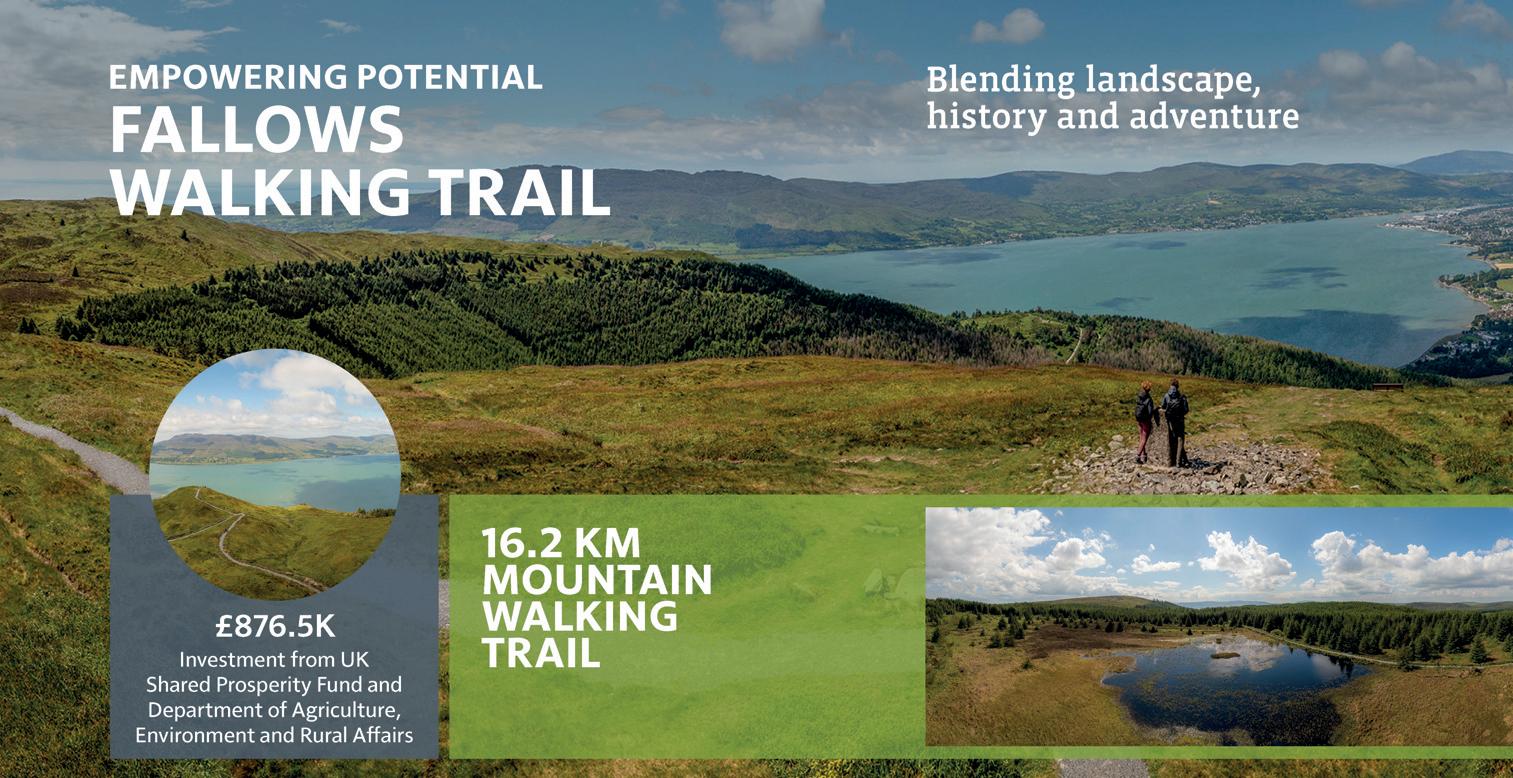
work with the Mae Murray Foundation, ensuring that visitors with mobility challenges have access to beaches at Tyrella and Cranfield. This development, funded through the UK Shared Prosperity Fund (UKSPF), ensures that tourism is accessible to all, aligning with the Council’s goal of creating an inclusive destination.
Building a reputation for event tourism, the Council has successfully hosted high-profile events and festivals over the past decade, contributing significantly to the local economy. The launch of the ‘Giant Adventures’ brand in 2017 was a key step in this strategy. The brand’s annual flagship events, inspired by the area’s landscapes, myths and legends, have attracted visitors from far and wide. These events are a central part of the Council’s broader strategy to offer visitors unique and memorable experiences, driving tourism revenue and local economic growth.
Looking forward, the Council has set ambitious goals for the next five years, aiming for a 34 per cent increase in tourism revenue, targeting £112 million in revenue generation. Achieving this will require continued investment in infrastructure, digital innovation, and sustainable tourism practices, as well as increased marketing efforts and continued collaboration with local community and businesses.
A key pillar of future growth is the £44 million Mourne Mountains Gateway Project, funded by the Belfast Region City Deal, which aims to attract global tourists and elevate the district’s international standing. This landmark investment in Newcastle will create a world-class visitor attraction, offering a gondola experience from Donard Park to a new visitor centre at Thomas Quarry.
Partnerships will continue to be fundamental as we explore a suitable location for Northern Ireland’s first Tree Top Walk, providing visitors with a unique perspective of the district’s stunning landscapes. By leveraging the strengths of its natural and cultural assets and tapping into growth markets such as business tourism, the district is poised to flourish as a prime tourism destination.
Newry, Mourne and Down District Council’s Tourism Strategy has already yielded impressive results but the work is far from complete. With a clear vision for the future, through strategic investments, strong partnerships, and a focus on sustainability and inclusivity, the Council aims to set itself apart and create a vibrant, thriving tourism economy that benefits both residents and visitors alike.
The future of tourism in Newry, Mourne and Down is bright and the Council is ready to lead the way in shaping the next chapter of its growth.
W: www.newrymournedown.org

In Armagh City, Banbridge and Craigavon Borough, the council’s leadership role in place-shaping is evident through long-term planning, significant investment, and sustained engagement with residents, stakeholders, and partners to shape places that are vibrant, inclusive, and resilient.
Amid financial pressures, diverse community needs, and a complex political context, place-shaping offers councils a unique opportunity to convene government departments, private sector partners, and community organisations to create a shared vision for their places. It enables tailored responses to local challenges, ensuring that investment is impactful, place-sensitive, and community-informed.
role of place shaping in local government
Place-shaping extends beyond physical regeneration to encompass how people experience and interact with the places where they live, work, and visit. It recognises that successful places reflect the identities, values, and aspirations of their communities. Councils play a central role in this process – engaging residents, aligning resources, and embedding sustainability, connectivity, and well-being at the heart of local development.
In Armagh City, Banbridge and Craigavon, the council’s place-shaping agenda is grounded through our Community Planning Partnership bringing comprehensive community engagement, strategic planning, and a commitment to delivering tangible improvements in people’s daily lives. Through the development and implementation of place plans across urban settlements, the council is helping to shape places that are attractive, economically viable, and socially connected.

The borough’s three place plans to date are tangible expressions of placeshaping in practice, tailored to reflect the unique character, assets, and opportunities and challenges of each area:
Armagh Place Plan: Focused on heritage-led regeneration, this plan is celebrating Armagh’s ‘Stars and Stories’ helping transform historical buildings into contemporary mixed-use spaces. The Armagh Townscape Heritage project, backed by over £6.3 million in investment, is repurposing 35 listed properties for residential and commercial use – helping to reinvigorate the city centre and support sustainable urban living.
Banbridge Place Plan: With vision to create a ‘Banbridge of tomorrow’ whilst celebrating its innovators and independents. A key investment of £6 million through a public realm scheme is revitalising the town centre, improving accessibility and aesthetic quality while encouraging increased footfall to support local businesses and economic growth.
Dromore Place Plan: Set for launch in May 2025, this plan will work with the proactive community sector and other partners to “restock Dromore” with economic growth, assets and life whilst fostering its historic fabric and strategic location.
Integrating the borough’s rich heritage into place-making strategies has proven a powerful tool for sustainable development. Projects in Armagh and Lurgan are repurposing heritage buildings to meet contemporary needs while preserving their architectural and historical value.
This approach supports environmental sustainability through the reuse of existing structures, while also contributing to economic vitality and community identity – demonstrating how heritage can be a living asset within modern place-shaping frameworks.
The ABC Community Planning Partnership are helping embed and ensure strategic investment in placemaking projects – ranging from public realm improvements to enterprise support and community infrastructure – is critical to the borough’s place-shaping ambitions. The council’s collaboration with the National Lottery Heritage Fund on a 10-year programme is a key example, addressing challenges linked to the built, natural, industrial, and cultural environment to create more resilient, attractive places.
Additionally, initiatives such as festivals, public art, and local enterprise programmes enrich the social and economic life of the borough and foster a deeper connection between people and place.
Despite the clear benefits, place-shaping is not without its challenges. Councils must navigate tight budgets, siloed governance structures, and increasing demand for services – all while delivering
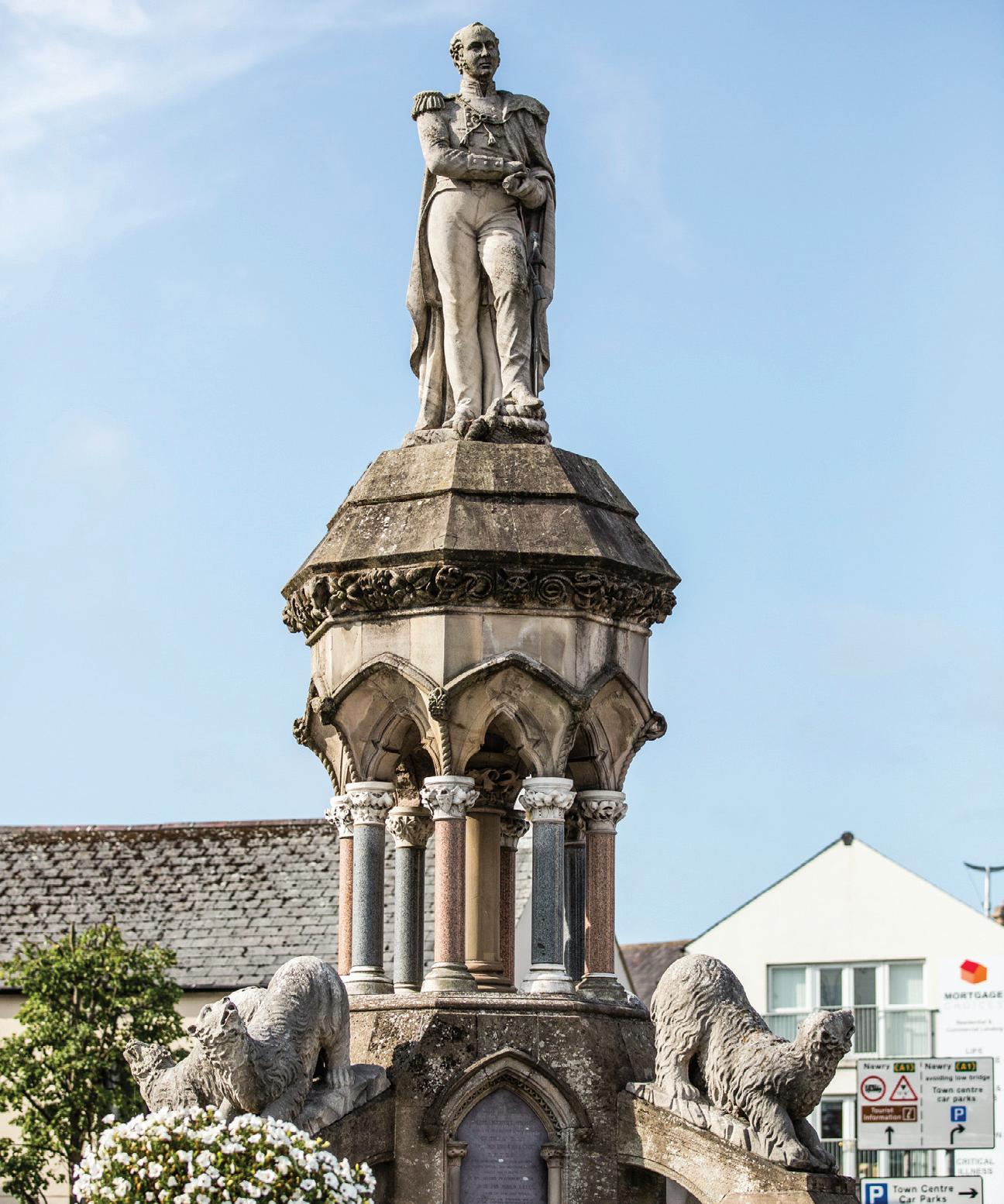
on ambitious local development goals. The complexity of aligning multiple stakeholders and funding streams can also hinder progress.
However, these challenges present opportunities for innovation, co-design, and partnership working. By aligning place-shaping within community planning, councils and partners can create longterm frameworks that are flexible, inclusive, and responsive to changing needs.
Looking ahead, place-shaping has the potential to redefine how local government delivers value – moving from service provision to community transformation. With strong leadership, collaborative partnerships, and communities who are engaged and

involved in both decision making and delivery, councils can shape places that support economic opportunity, environmental sustainability, and social cohesion.
In Armagh City, Banbridge and Craigavon, the council remains committed to leading this work, ensuring that the borough’s places are not only fit for today but resilient and aspirational for generations to come.
For more information contact: Elaine Gillespie, Head of Community Planning, Armagh City, Banbridge and Craigavon Borough Council Email: elaine.gillespie@armaghbanbridgecraigavon. gov.uk
Spending by councils 2022/2023
£1.2 billion collectively spent by 11 councils.
• Equivalent to £650 per resident
o 10% lower than Scotland (£720/resident).
o 30% lower than England (£930/resident).
of spending

Source: Department for Communities.
Total political representation
Sinn Féin: 144
DUP: 122
Alliance: 67
Independent/other: 45
Source: Electoral Office Northern Ireland.
Source: Electoral Office Northern Ireland.
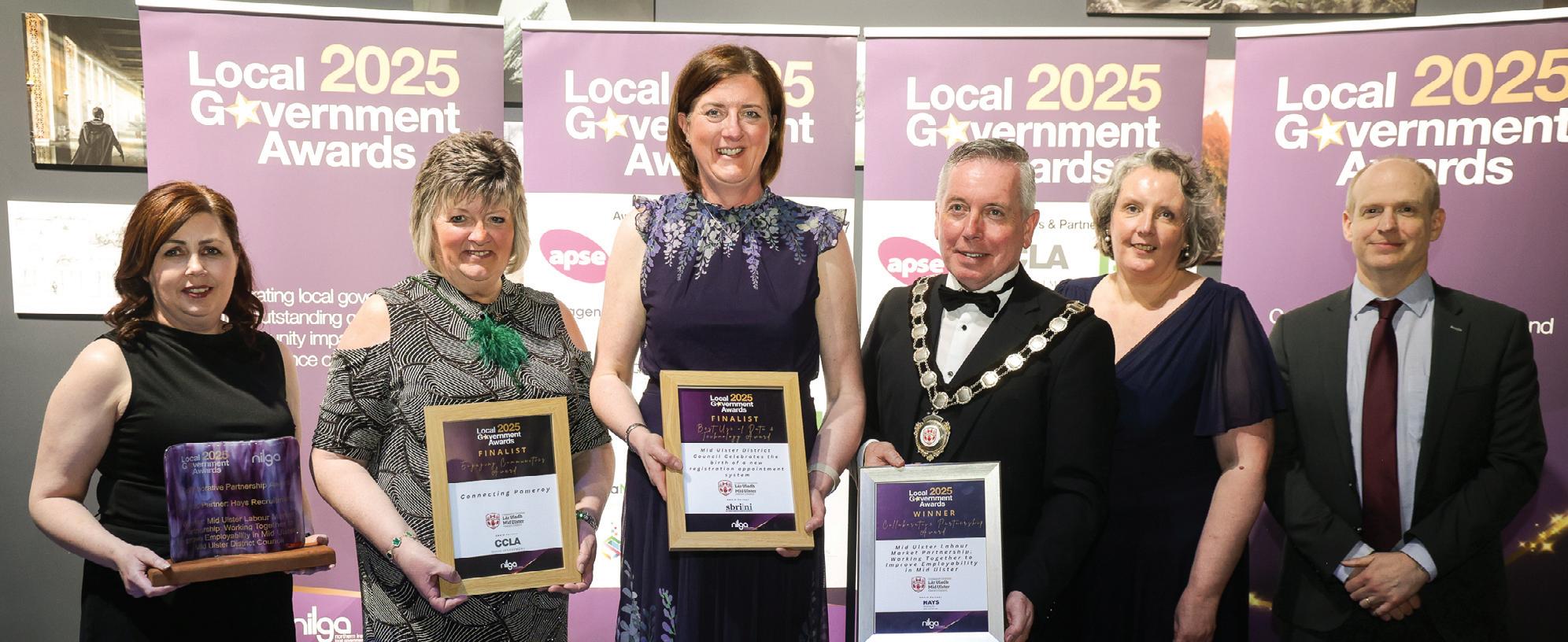
Over the past 10 years, Mid Ulster District Council has undergone significant transformation, reflecting broader technological, economic, and social changes across local government.
Since 2015, it has played a key role in driving regional development, improving community services, increasing resident health and wellbeing, and promoting economic growth. It has been at the heart of its community working in partnership with others locally and regionally to make Mid Ulster a great place to live in, work in, invest in, and to visit.
As well as delivering statutory services against a backdrop of ever decreasing external funding, the council has delivered, advocated for, and secured multimillion-pound investment in infrastructure, business development, and community-based initiatives across the district to enhance the wellbeing of residents and growth of the areas’ business base.
One of the most notable achievements has been the council’s focus on economic development and job creation, most recently recognised at the 2025 NILGA Local Government Awards when the Mid Ulster LMP, which is facilitated by the council, was winner of the
Collaborative Partnership Award (pictured above).
Over the past decade, the council has strengthened partnerships with local businesses, launched enterprise support programmes, and invested in infrastructure to sustain and grow the local economy. Undertaking no less than five public realm schemes, providing sustained support for rural development, and lobbying strongly for improved digital connectivity have all helped to reinforce Mid Ulster’s role as a key contributor to the region’s economy.
Environmental sustainability has become an increasing priority. The council has implemented recycling campaigns, invested in renewable energy for its public buildings and fleet, and worked towards biodiversity protection in local green spaces. The recent introduction of a climate change strategy and action plan, as well as participation in regional sustainability initiatives mark an important shift in long-term planning and environmental responsibility.
Mid Ulster District Council has matured into a more integrated and forwardthinking local government authority over the past 10 years. It developed an ambitious Digital Transformation Strategy in 2022 which aims to establish the organisation as a leading digital council. It enables the council to leverage the opportunities provided by technologies to innovate and improve, and to realise cultural, organisational and operational change, adding value for the organisation, stakeholders and most importantly customers.
Looking ahead to the next decade, it has pledged to be a council for everyone, delivering its services in a user friendly, accessible, and efficient manner, continually striving to improve everything that it does. With improved service delivery, economic investment, and a focus on sustainability and community wellbeing, it is well-positioned to continue shaping a dynamic future for the region.
W: www.midulstercouncil.org
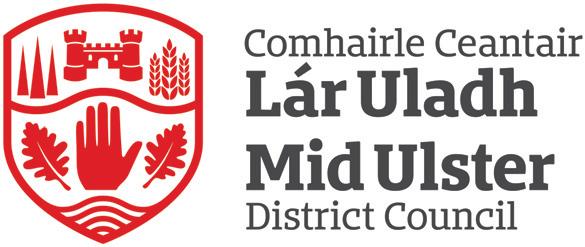
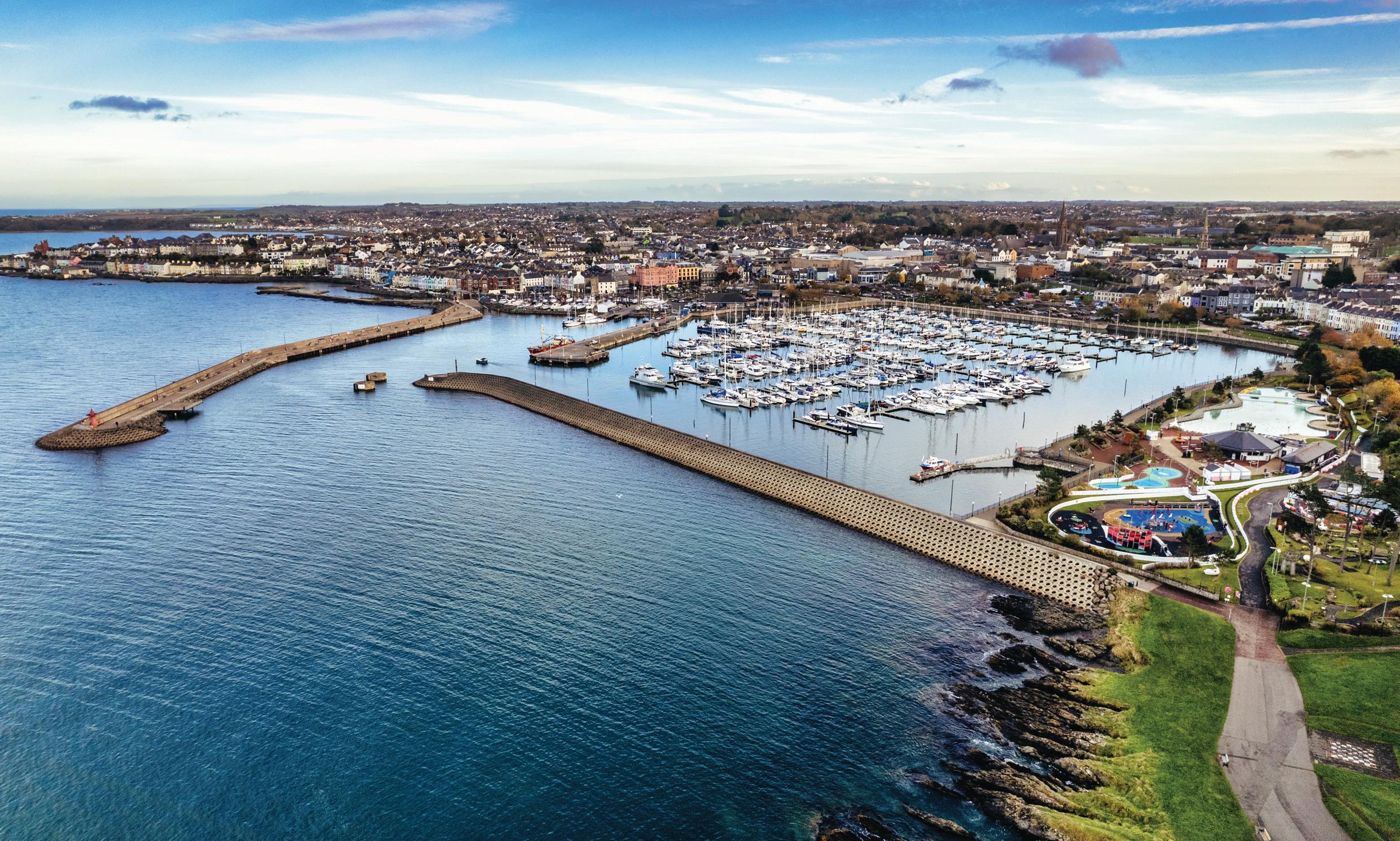

Ards and North Down is a region brimming with natural beauty, rich heritage, and vibrant communities. This feature explores the unique aspects that make it a must-visit destination for tourists and a fantastic place to invest or grow a business, as well as a wonderful place to call home.
Ards and North Down is a hub for economic growth and innovation. With a strong focus on sectors such as advanced engineering, Creative Digital and Agri-food, the region offers numerous opportunities for businesses and entrepreneurs. Ards and North Down Borough council’s initiatives like the Blue: Green, Creatively Connected strategy are helping to create a thriving and prosperous environment for both residents and businesses.
Over the past year, the council’s economic development service has delivered a range of innovative programmes providing critical support to more than 1,400 local businesses. These programmes have significantly enhanced operational capabilities and market competitiveness across the borough.
The council’s offering has included targeted programmes in agri-food, supporting the food and drink sector; and a Female Leadership Programme,
helping entrepreneurs enhance their business skills and gain Chartered Management Institute (CMI) qualifications. The Green Adaptation Programme enabled businesses to measure and reduce their carbon footprint, while the Labour Market Partnership (LMP) provided funding for an Employee Upskilling programme, supporting over 200 people to achieve qualifications and sustainable employment in the area with employers including Tesco, Lidl, Hays, South Eastern Trust, and Amazon.
Ards and North Down is home to exceptional talent, significant retail centres, and a rich tourism offering. Renowned for Agri-food businesses, advanced manufacturing, and creative technology hubs, the region is a proven location for success. Major companies like Spirit Aerospace, Denman, Whale,
3M, Lakeland Dairies, Mash Direct, and Teleperformance thrive here. With strong connectivity to Belfast and Dublin, and leading digital infrastructure, it is an ideal choice for professional relocation and business growth.
Businesses are drawn to Ards and North Down due to its accessibility and affordability, while residents benefit from a thriving local economy and coastal charm. The dynamic borough offers an exceptional environment for enterprises seeking to establish a foothold in Europe.
The council offers tailored business support, developing business infrastructure, and fostering partnerships with key industry players. Land holdings in Bangor, the largest city in the council area, are being explored for commercial development, while initiatives such as business mentoring programs and market access strategies further strengthen the business landscape. The council is progressing ambitious plans to redevelop a two-mile stretch of the Bangor seafront over the next 10 years, to help re-establish Bangor as a thriving city and prime visitor attraction in Northern Ireland.
The Bangor Waterfront Redevelopment is just one of a number of exciting tourism-led regeneration schemes that was eligible to receive funding from the Belfast Region City Deal. Council has been awarded £40
million for the 10-year development via a bespoke package of funding from the Department for Communities, with £20 million secured from Council and an additional investment of £12.8 million being sought from private investment.
Susie McCullough, Chief Executive of Ards and North Down Borough Council, says: “We are ideally located just minutes from Belfast City Airport, making it easy for businesspeople to connect with global markets. However, our true strength lies in our exceptional workforce: highly skilled, well-educated, and renowned for its low turnover. Beyond expertise, our local talent embodies a strong entrepreneurial spirit, driving innovation and startups across a diverse range of industries.”
Northern Ireland’s creative industries are experiencing significant growth, with start-ups and SMEs flourishing in areas like film, digital media, gaming, and design. The region, internationally acclaimed for productions like Game of Thrones, continues to attract investment and stimulate economic growth. The Holywood Innovation Hub, also known as the Creative Innovation Hub, is a promising initiative for Ards and North Down. It aims to be a centre of excellence for the creative and technology sectors, with a particular focus on film, TV, and screen industries. This project has been earmarked for funding from the Belfast Region City Deal.
Holywood is already home to a number of leading screen industry innovators specialising in production and postproduction for TV and film, animation, design, and games development. These include Waddell Media, Italicpig, Flickerpix, Paper Owl Films, and Yellow Moon, who develop innovative products and provide essential services to many of the biggest players in screen industries such as BBC, RTÉ, Universal, HBO, and Netflix.
By embracing innovative strategies, such as providing ready-built facilities for businesses, we are committed to making Ards and North Down the top choice for investors, further contributing to Northern Ireland’s ambition to become a global hub for the screen industry.
The region shares rich cultural and historical ties with the United States, with Bangor playing a crucial role during

World War II. Ongoing commemorations and visits from the US Consulate strengthen these connections, welcoming businesses seeking opportunities in Ards and North Down.
We are already home to major investors like Brunswick Corporation, an American company focused on the production and distribution of a wide array of products, including marine engines, boats, and various parts and accessories. Bangor is a hub for Brunswick’s marine parts and accessories division. They expanded their local facilities and now produce 99 per cent of the pumps used in portable toilets around the world, designed and manufactured right here in Bangor.
Boasting Northern Ireland’s longest coastline, picturesque villages, and rich cultural heritage, Ards and North Down is one of the most desirable places to live. Investment in public green spaces and infrastructure, such as the 40-kilometre greenway network linking major towns, enhances residents’ quality of life.
Iconic attractions like Pickie Fun Park and the historic National Trust’s Mount Stewart estate draw visitors, while activities such as Strangford Lough canoeing tours paired with authentic Irish cooking classes offer memorable experiences.
Ards and North Down has several awards and recognition programs for businesses, which celebrate excellence in various sectors, including innovation, customer service, sustainability, and community impact. The Ards and North Down Business Awards recognise outstanding achievements by local businesses in categories such as best new business,
best customer service, and best use of digital marketing, whilst the Taste AND Awards celebrate the local industry’s achievements annually, highlighting a wide range of producers from across the Borough and their successes.
2025 will see the inaugural Ards Peninsula Business Awards, a collaboration between Newtownards Chamber of Trade, Love Local Comber, and Visit Donaghadee, in association with Ards Business Hub. A very welcome addition to the local business calendar, these awards recognise the hard work and achievements of local businesses in the Ards Peninsula area, as they play a crucial role in driving economic growth and innovation. The awards highlight the remarkable talent and dedication within this community, spanning sectors from artisan producers and hospitality to manufacturing and technology.
Join us in Ards and North Down!
Whether you are planning a visit or considering a move, Ards and North Down is ready to welcome you. Experience the charm, beauty, and opportunities that this remarkable region has to offer.
We have made incredible progress over the past decade, and we invite you to be part of the exciting journey ahead. Join us and see what the next 10 years have in store!
W: www.ardsandnorthdown.gov.uk

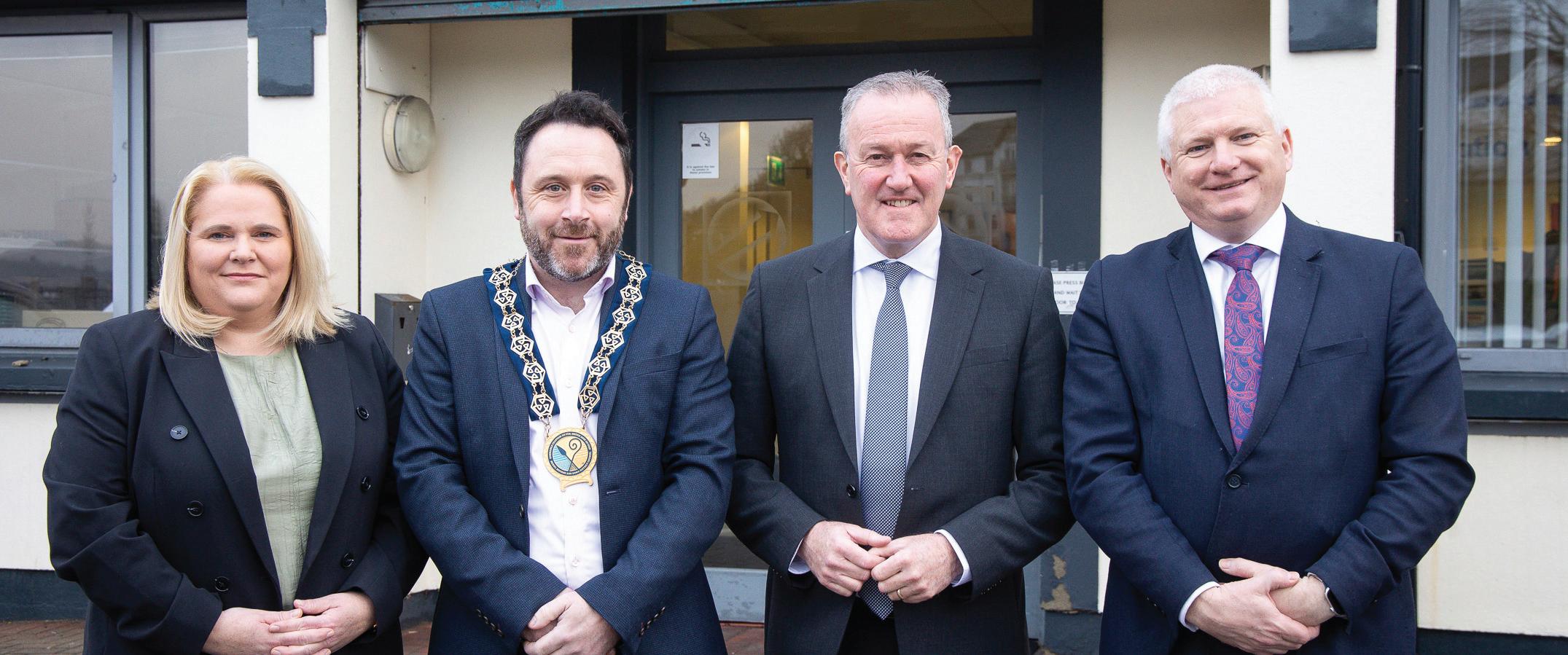
In January 2025, the Department for the Economy (DfE) announced the allocation of a £45 million Regional Balance Fund over three years. The fund will be available to help form local economic partnerships (LEPs), which will be led by councils.
The Department states that the fund will be allocated using the following formula:
• 30 per cent allocated equally to all councils;
• 30 per cent based on productivity performance measured by output per job; and
• 40 per cent based on peripherality, based on small area classifications as per the OECD’s regional typology methods.
Councils such as Derry City and Strabane, classified as peripheral, will be entitled to funding of £1.72 million annually, totalling £5.15 million over three years – the highest allocation under the fund.
In contrast, more central areas like Antrim and Newtownabbey are set to receive £956,000 annually, amounting to £2.87 million over the same period.
The fund’s objectives align with the broader SubRegional Economic Plan, which prioritises enhanced productivity, job creation, and balanced regional development. LEPs are expected to collaborate with local businesses, educational institutions, and government agencies to develop
targeted strategies that reflect the unique economic characteristics of each area.
Invest NI will play a key role in supporting LEPs, with plans to increase staffing in regional offices by 40 per cent to improve outreach and provide tailored business support. This enhanced capacity aims to strengthen local supply chains and foster innovation in high-potential sectors.
The Regional Balance Fund reflects a strategic commitment to addressing longstanding economic imbalances in Northern Ireland. By empowering local councils and targeting funding based on economic need and geographical context, the fund aims to create a more resilient and inclusive regional economy.
When the funding was announced, then-Minister for the Economy Conor Murphy said: “This £45 million investment over the next three years underscores our commitment to addressing regional disparities and empowering local councils to drive economic growth tailored to their unique challenges and opportunities.”

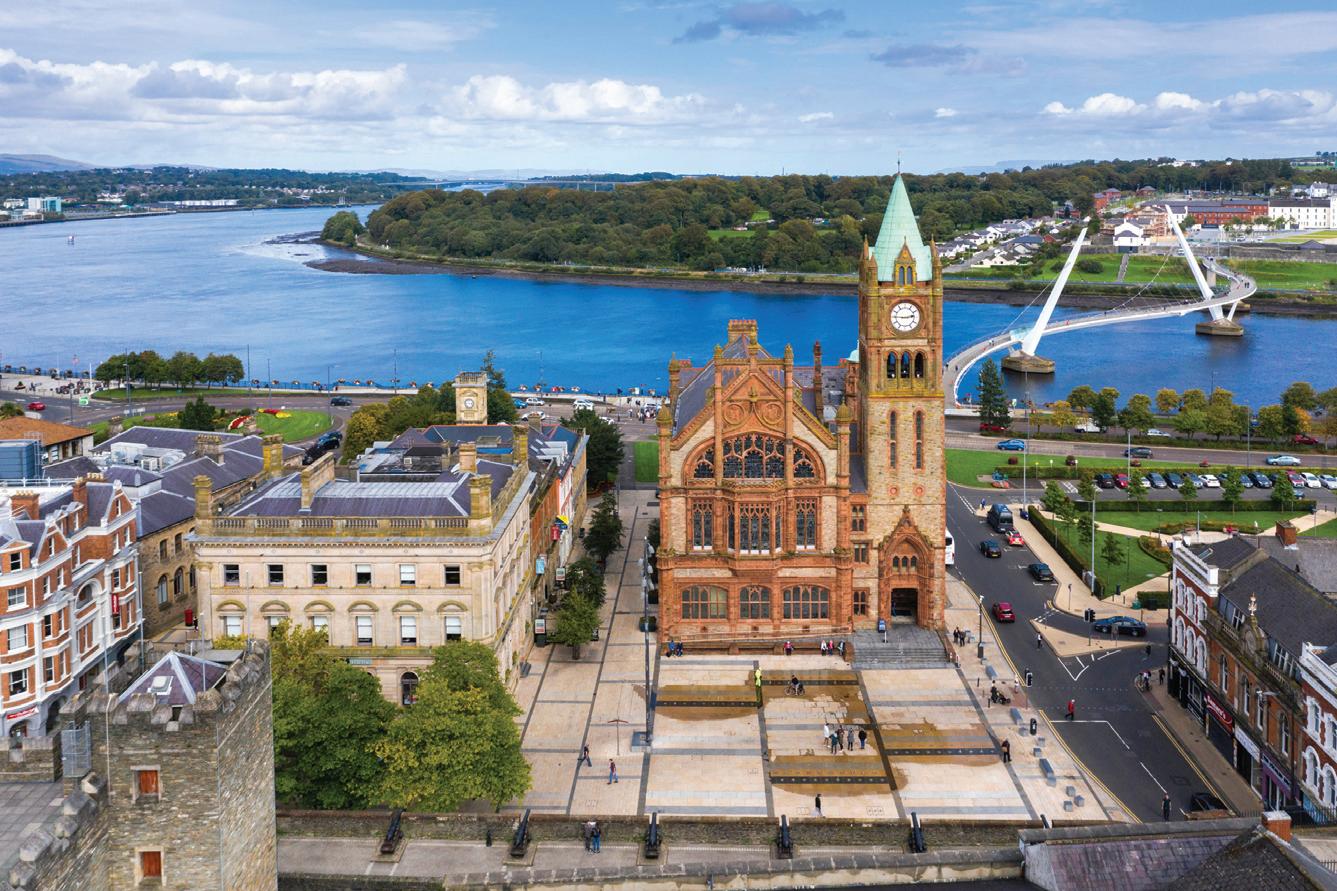
Ten years ago, Derry City Council and Strabane District Council embarked on an exciting new chapter, merging to form the Derry City and Strabane District Council.
This amalgamation, while presenting initial challenges, has proven to be a catalyst for growth, progress, and positive change across the entire region. As we celebrate this significant milestone, we can proudly reflect on a decade of remarkable achievements and the tangible benefits they have brought to our communities.
One of the council’s most significant accomplishments has been securing the transformative Derry-Londonderry and Strabane City Region City Deal and Inclusive Future Fund. This substantial investment of over £290 million represents a major vote of confidence in our region’s potential. These funds will be instrumental in driving innovation, enhancing digital connectivity, and creating high-skilled jobs, ultimately shaping a more prosperous future for Derry and Strabane. This achievement is a testament to the council’s strategic vision, collaborative approach, and unwavering commitment to securing the best possible outcomes for our citizens.
Beyond this landmark funding, the council has consistently delivered improvements across a wide spectrum of
essential services. From the efficient management of waste and recycling to the streamlined processing of planning applications, the council’s dedication to enhancing the daily lives of residents is evident. The significant investment in community facilities, and the revitalisation of our parks and green spaces has created vibrant community areas, providing valuable spaces for recreation, leisure, and social interaction. Furthermore, the council has played a vital role in supporting local businesses, fostering a dynamic and resilient economic landscape and reaching out to support those in the community and voluntary sectors.
The development and implementation of the Strategic Inclusive Growth Plan has provided a clear and comprehensive roadmap for the district’s sustainable growth. This plan, created with input from our partnerships, articulates a shared vision for a thriving, prosperous, and inclusive region. It prioritises equality of opportunity, ensuring that all residents have the chance to reach their full potential and contribute to the region’s success.
Acknowledging the urgent need to address climate change, the council has made significant strides in environmental sustainability. The Climate Change Adaptation Plan demonstrates a proactive approach to mitigating the impacts of climate change and protecting our natural resources for future generations. By investing in renewable energy, promoting sustainable practices, and raising awareness about environmental issues, the council is continuing to work to create a greener and more resilient region for all of us to enjoy.
Derry City and Strabane Council has also been a passionate advocate for our rich cultural heritage, actively promoting tourism and showcasing the unique identity of Derry and Strabane to a global audience. Through support for world class festivals, cultural events, and heritage sites, the council is celebrating our history, nurturing creativity, and attracting visitors from around the world. From our internationally renowned Derry Halloween festivities to the City of Derry Jazz and Big Band Festival to the St Patrick’s Day Spring Carnival, these initiatives enrich our cultural landscape and contribute to the vibrancy of our communities.
While challenges undoubtedly remain, particularly in addressing issues such as unemployment and social inequality, the progress achieved over the past decade provides a solid foundation for our future.
As we look forward, Derry City and Strabane District Council remains steadfast in its commitment to working in partnership with our communities, businesses, and stakeholders to build an even brighter future for the region. This 10-year anniversary is not simply a moment to celebrate past successes, but a springboard for even greater achievements in the years to come.
W: www.derrystrabane.com
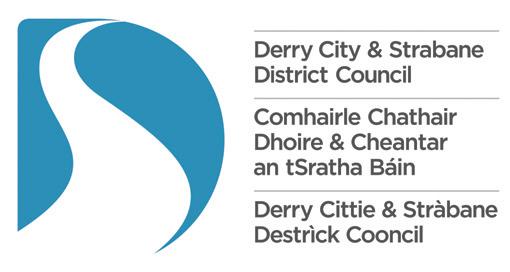
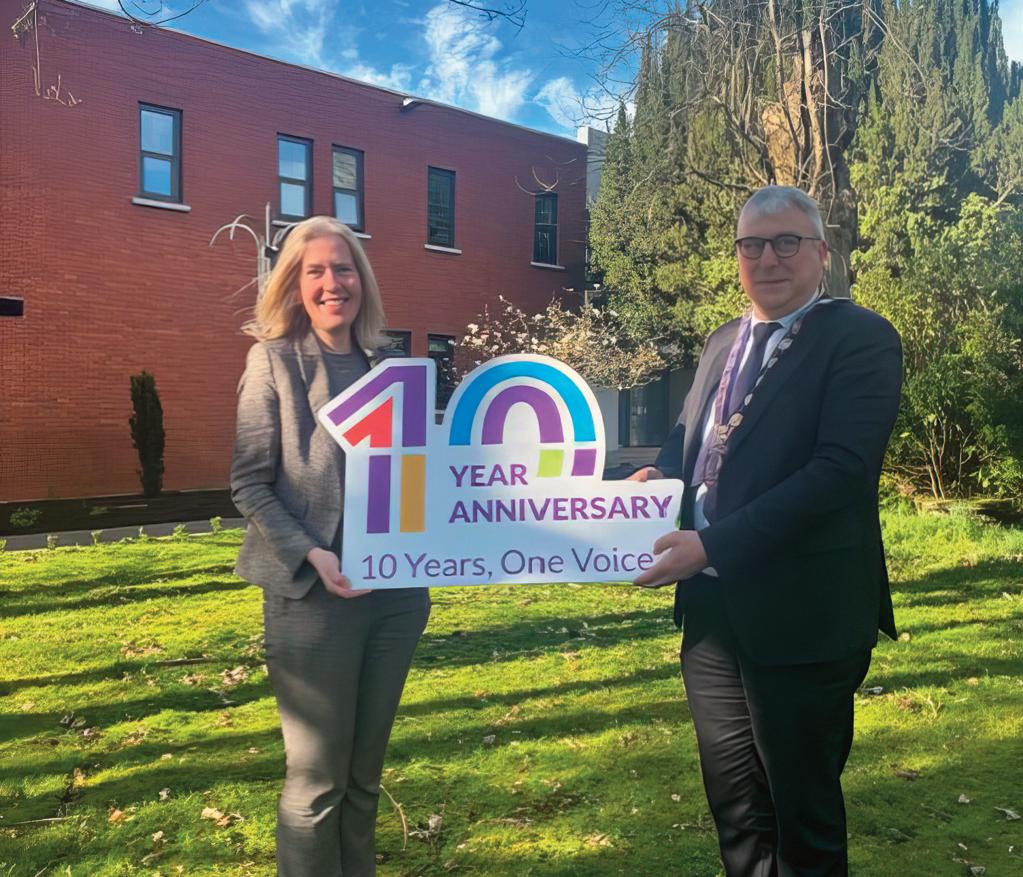
Since 2015, Fermanagh and Omagh District Council has worked in partnership with others to advocate for and improve the social, economic, and environmental wellbeing of the District. It has been the voice of the area, delivering high quality services, supporting communities and enabling multi-million pound investment in infrastructure to enhance the wellbeing of residents.
The Council embraced its new powers and responsibilities, and were the first council in Northern Ireland to publish its local development plan, plan strategy and also led the development of the first Community Plan for the District, working in collaboration with community and business partners to deliver on the vision of a welcoming, shared and inclusive Fermanagh and Omagh, where people and places are healthy, safe, connected and prosperous, and where our outstanding natural, built, and cultural heritage is cherished and sustainably managed.
There have been challenges: Covid-19, economic downturns, and fluctuating government funding. However, the Council has remained committed to delivering high-quality services. With careful financial planning and partnership working, the Council has
Fermanagh and Omagh District Council is set to mark its 10year anniversary with a series of special events to acknowledge the significant contributions of communities, partner organisations, elected members and staff in improving the wellbeing of citizens and wider District over the past decade.
supported communities and in 2024 was the first council in Northern Ireland to launch a 10-year anti-poverty strategy, providing support for the most disadvantaged.
The Council has also delivered public realm improvements in Enniskillen and Omagh, revitalisation programmes in local towns and villages, transformed Gortin Glen Forest Park into a must visit destination and Enniskillen Workhouse into an innovative business enterprise and heritage hub.
The Council have prioritised tourism initiatives and product development and have proudly supported a whole variety of events across the District.
Millions of pounds have been awarded to community groups across the District through the Council’s grants programme and to upgrade playparks to ‘gold’ and ‘silver’ standard, increasing accessibility.
Thousands of businesses have benefited from its business support programmes, hundreds of new jobs have been created and opportunities to develop new skills to meet market demands.
The Council is also working to protect and enhance the environment, launching its 10year climate change and sustainable development strategy in 2020; reducing
carbon emissions from the Council fleet and estate and managing more than 160 hectares of land for biodiversity.
Looking ahead, the Council is focussed on supporting its residents and communities, promoting shared prosperity across the District, meeting the challenges of climate change and ensuring the Council as an organisation is agile, effective and efficient.
A series of events will celebrate ‘10 Years One Voice’ in Fermanagh and Omagh and the exceptional contributions of local communities, elected members and council staff. The events, which will take place throughout the anniversary year, will provide an opportunity to reflect on the progress made, recognise individual and collective achievements, and to look ahead.
T: 0300 303 1777 W: www.fermanaghomagh.com

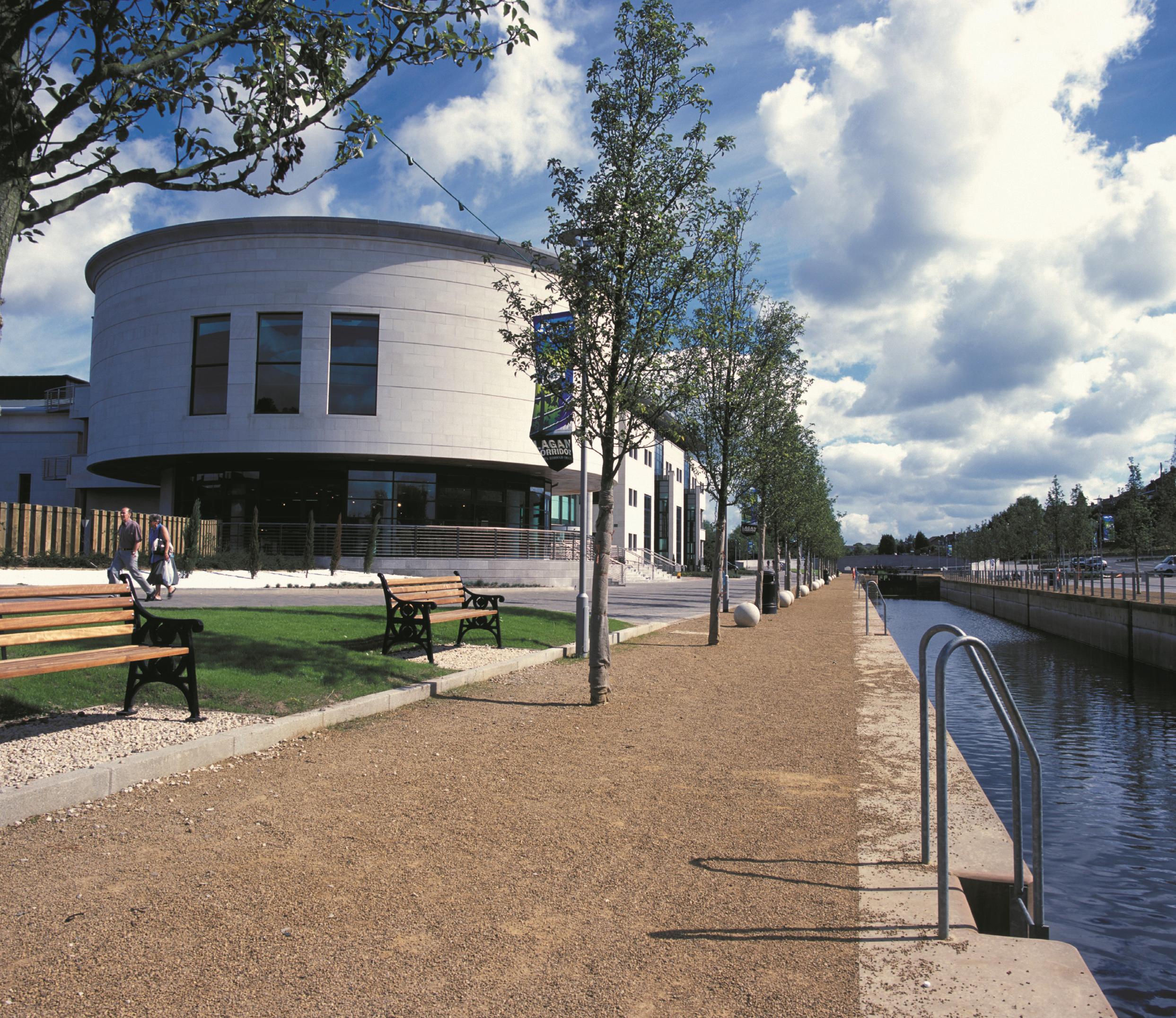
The response by the Department for Communities (DfC) to the 2021 Review of Role and Responsibilities of Councillors in Northern Ireland (NI) indicates that there is a lack of awareness of support mechanisms available to local councillors, at a time when they face increasing pressure, and prospective members face barriers to entry.
The review asserts that local councillors view the existing allowance system and a lack of a maternity/paternity scheme as gaps in support for elected members. It also notes: “The role of the councillor has become more complex, multi-faceted, and continues to change with councillors being now viewed as advocates for change.”
Conducted by a working group (WG) appointed by DfC, it claims that many constituents go to councillors to raise issues that MLAs are appointed to deal with. This arises from the fact local councillors live and work in the area they represent, making them more accessible than MLAs.
A survey completed by the WG including responses from 62 per cent of the 462 councillors in Northern Ireland found that 70 per cent faced “abuse and/or harassment because of their role”. It notes: “The WG believes that addressing the challenges associated with personal security, use of social media, and attracting younger councillors are as integral to the future of healthy local democracy as remuneration and terms and conditions.”


Data from the Local Government Pension Scheme (LGPS), of which 425 of the 462 councillors in Northern Ireland are members, sheds light on the make-up of elected officials. A plurality of councillors are aged between 45 and 49, while 293 (69 per cent) of the 425 LGPS members are male, and 132 (31 per cent) are female. The review says: “Concerns were expressed to the WG by stakeholders about the growing need for councillors to be more reflective of the society which they serve.”
On foot of the review, the WG made numerous recommendations to DfC to address the challenges, with two being accepted. DfC agreed to transfer the duty of deciding members’ basic allowance (BA) from councils to the Department, and that the next review of the role of local councillors be completed before 2031.
Existing BA of £17,030 was deemed inadequate by the review which says “it does not reflect the more challenging roles undertaken by councillors”. The WG requested that the BA be increased from £17,030 to £21,925, subject to two further increases in line with inflation and public sector average earnings.
This proposal was rejected by DfC, which deemed it “unaffordable in the current climate”. Increasing the BA to £21,925 would have resulted in an additional annual cost of approximately £2.26 million to the Executive. Instead, the Department recommended that BA increase to £18,329, a 5 per cent growth on the 2024 allowance based on councillors’ working hours increasing from 18.5 hours to 20 hours per week. Any additional time councillors dedicate to the role is done so on a voluntary basis, according to the review.
The review found that 46 per cent of respondents dedicate between 20 and 30 hours per week to their role while 26 per cent dedicate between 30 and 40. The survey found that 57 per cent of respondents are in full time employment while 23 per cent work part time.

According to DfC, many of the measures the WG recommended be implemented are already within the remit of local authorities. For example, the WG recommended that all chairs and vice chairs receive payments of Special Responsibility Allowance (SRA).
The WG explained that these payments “vary considerably” between councils while some “do not remunerate these positions at all”. However, the Department asserted that it is up to each council to decide how SRAs are paid.
The WG also said “serious consideration” should be given to the remuneration of party leads, but the DfC said this is a decision made by councils. On travel and subsistence, the WG requested that guidelines be established on which approved duties should have costs covered. It was noted that the payment per mile varied across councils from 45p per mile to 65p. This was rejected by DfC on the basis that councils are “responsible for their own budgets”.
The Department also rejected the WG’s recommendation that a database outlining councillors’ age and gender be
compiled “to be more reflective of the society which they serve”. DfC rejected this as the information is already available from public bodies like NI Local Government Officers’ Superannuation Committee and LGPS.
Minister for Communities Gordon Lyons MLA officially announced the changes in a statement in March: “I am pleased that the Executive has unanimously agreed to the proposals that I have brought forward. I have considered carefully the recommendations in the report and, in doing so, I needed to balance any increase in the basic allowance for councillors against the cost to ratepayers in what is an extremely challenging financial climate. I need to ensure that increases in rates bills are kept to the minimum.
“Against a backdrop of wider public sector settlements generally in and around this level, I am content that this 5 per cent increase for councillors is justified given the volume and complexity of council duties, the hours required to carry them out, and the fact that the role and responsibilities of councillors was last reviewed in 2013.”
These statistics encompass the period between 2015 and 2022, accounting for the seven year period after planning was devolved to local government in Northern Ireland.
Planning applications
Around 12,500 planning applications processed annually since 2015

Regionally significant and major applications
Statutory target: 30 weeks
Only 26% processed within target (2017-2020)
48% within 1 year
20% took more than 3 years
2016-2021: Of 7 ‘regionally significant’ applications, only 1 was processed within 30 weeks; 4 took over 3 years
Local applications
Statutory target: 15 weeks.
Achieved in 2018-19 and 201920
Between 2017-2020:
• 51% processed within 15 weeks
• 77% within 30 weeks
• 10% took more than 1 year
Local development plans (LDPs)
Intended timeline: 3.5 years per council
Actual progress by 2022: 0 of 11 councils completed a full LDP within intended deadline.
Estimated completion: By 2028
Cost per council to date:
Between £1.7 million and £2.8 million
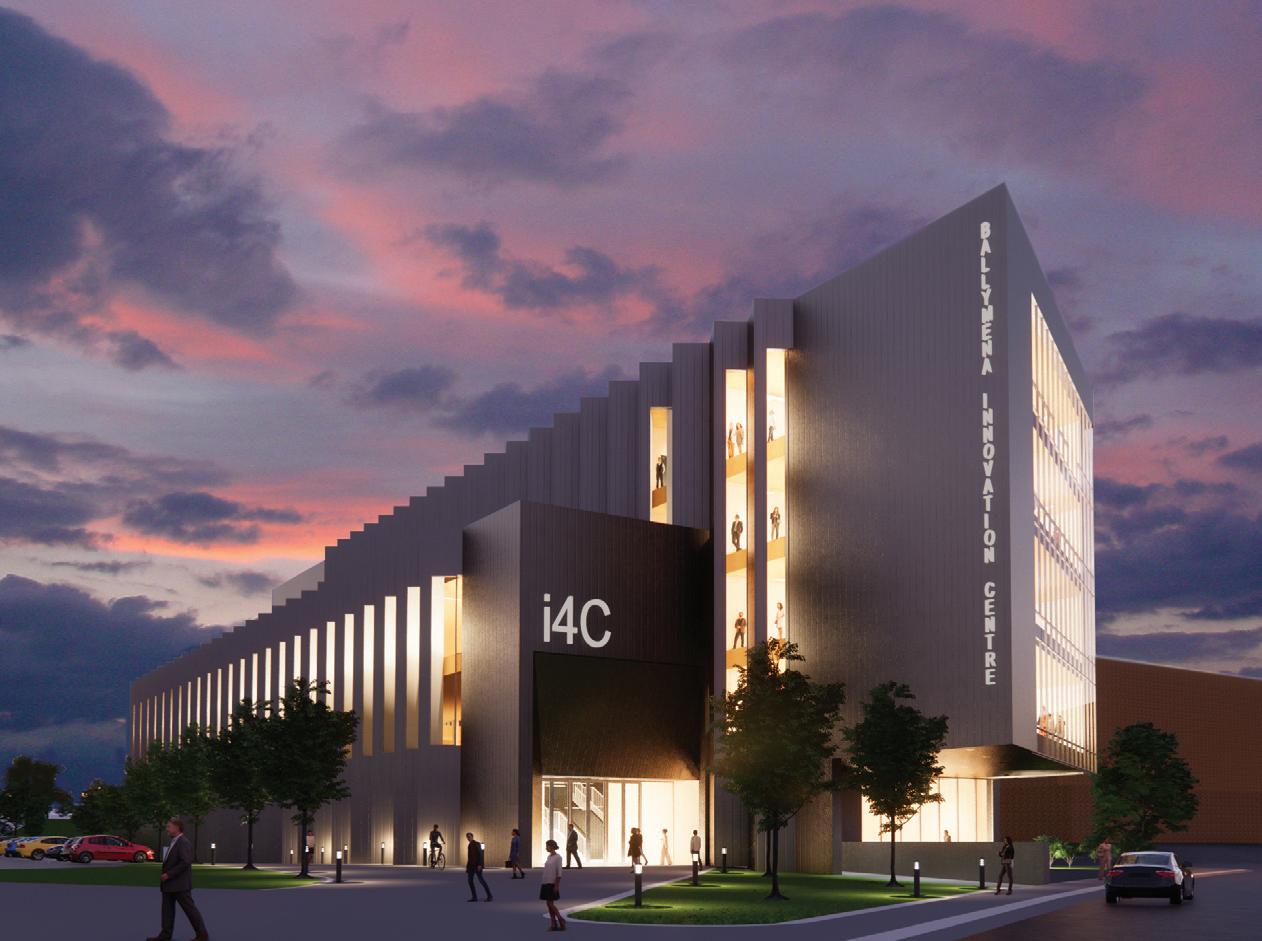
Mid and East Antrim Borough Council is leading the charge in clean technology development across Northern Ireland, placing innovation, sustainability and economic growth at the heart of its vision for the future.
Central to this ambition is the i4C Innovation and CleanTech Centre, a landmark £24 million project being delivered as part of the Belfast Region City Deal. Situated at the former St Patrick’s Barracks site in Ballymena and close to world-leading global zero emission vehicle manufacturer, Wrightbus the centre will act as a catalyst for clean energy innovation, supporting businesses to develop and scale cutting-edge technologies. Once completed, i4C will provide specialist workspaces and collaboration opportunities as well as access to the resources required to drive green growth across the region. This state-ofthe-art hub is set to transform how businesses in Mid and East Antrim engage with clean technology –attracting investment, fostering partnerships and creating high-value
jobs. With the design team now appointed and plans progressing at pace, the i4C Centre represents a bold step towards a more sustainable, competitive economy and signals the Council’s long-term commitment to lowcarbon innovation and environmental responsibility.
Alongside this, Council is advancing its HyTech NI project – a £15 million hydrogen innovation project in collaboration with QUB and Ulster University focused on developing the skills, infrastructure and industrial capability needed to power Northern Ireland’s hydrogen economy. While still in early stages, HyTech NI has brought together industry leaders to explore how hydrogen can deliver cleaner energy solutions and support long-term decarbonisation. The initiative is expected to play a key role in
establishing the region as a credible leader in hydrogen expertise.
These flagship initiatives build on the strong foundation of Council’s Manufacturing Task Force, which has driven collaboration across local industry since 2018 by connecting some 50+ manufacturers with government, academia and other stakeholders to identify opportunities for innovation and supporting the transition to net zero via the public and private sector funded CleanTech Collaborative Growth Network, the only one of its kind in Northern Ireland.
Complementing these larger programmes is MEANZ Business, a two-year project supported by Innovate UK to help local SMEs reduce their carbon footprint. Through peer learning, expert guidance and tailored tools, MEANZ Business is supporting companies on their decarbonisation journey and encouraging more sustainable business practices.
In parallel, the multi-award-winning Hydrogen Training Academy is equipping the local workforce with practical skills aligned to emerging clean energy sectors, helping to close the capability gap and prepare for future demand.
By combining investment, innovation and collaboration, Mid and East Antrim is shaping a cleaner, greener economy. From advanced clean tech infrastructure to workforce development, the borough is positioning itself at the forefront of Northern Ireland’s sustainable transformation – and building a legacy of inclusive, low-carbon growth.
For more information email invest@midandeastantrim.gov.uk


Northern Ireland’s local councils are grappling with rising financial pressures, declining income, and growing workforce challenges, according to the Local Government Auditor’s Report 2024.
Covering the 2022/23 financial year, the annual review paints a mixed picture of local government performance, with progress in governance offset by challenges around long-term financial resilience and staffing.
The review, published in October 2024, asserts that councils collectively reported the largest income-expenditure gap since the 2015 reform, with a shortfall of £128 million – equivalent to 11 per cent of expenditure. The shortfall has been driven by falling income, particularly a sharp 54 per cent decline in government grants, alongside rising operational and staffing costs.
Despite efforts to maintain service levels post-pandemic, income from service charges and fees continued to fall for a second consecutive year. Capital investment also remains below pre-Covid levels, reflecting the strain on council finances and increasing uncertainty around large-scale infrastructure projects.
Staff costs account for 39 per cent of council budgets, totalling £436.2 million, with an additional £37.6 million spent on agency staff. Two councils –Causeway Coast and Glens and Mid and East Antrim – are identified as having particularly high reliance on agency workers.
Sickness absence is an escalating challenge, with an average of 16.9 days lost per employee – 37 per cent higher than in the Northern Ireland Civil Service. Councils have also highlighted acute difficulties recruiting and retaining staff in key roles including planning, procurement, and environmental health.
While all councils received unqualified audit opinions, a number of critiques are raised in the report for challenges such as outdated policies, weaknesses in procurement, and underreporting of fraud. Notably, the report states that there are continued delays in meeting statutory planning targets, with only 36.8 per cent of major planning applications processed within the required 30 weeks.
Speaking upon publication, Local Government Auditor Colette Kane said: “This gap between decreasing levels of income and rising expenditure is being experienced across most councils. I am concerned that any sustained continuation of this trend could potentially challenge the long-term financial sustainability of the overall local government sector. Financial resilience, through effective planning and strong oversight, will be crucial in the period ahead, and my report makes several recommendations in this regard.
“The data I have analysed shows that the income generated by councils, through charges and service fees, fell in both of the last two financial years. There may be merit, therefore, in councils considering the scope for increasing income generation, and for sharing details about initiatives they have taken or plan to take to maximise income going forward.
“My report also observes that the value of usable reserves held by councils continues to be higher than before the pandemic, totalling around £447 million in 2022/23. It is essential that councils have clear and robust plans in place for managing and using these reserves in a way that delivers maximum value and benefit for ratepayers.”

Following a local government reform, designed to empower councils in Northern Ireland, Antrim and Newtownabbey Borough Council was officially established on 1 April 2015.
The new council succeeded the former Antrim Borough Council and Newtownabbey Borough Council, bringing together their resources and governance to enhance service delivery to the community.
Ten years on, Antrim and Newtownabbey Borough has undergone significant transformation, emerging as a prime destination to live, work, invest, and visit. This progress is a testament to the Council’s strategic leadership and its unwavering focus on community-driven development.
Antrim and Newtownabbey Borough Council: Driving growth and sustainability
Through bold initiatives and visionary planning, Antrim and Newtownabbey Borough Council has become a leading force in fostering economic growth, enhancing public services, and shaping a sustainable future for its residents.
• economic growth and public service enhancement;
• development and infrastructure revitalisation;
• responsible financial management;
• progressive policies; and
• community engagement.
Antrim and Newtownabbey Borough Council remains steadfast in its commitment to enhancing the wellbeing of its residents, safeguarding the environment, boosting the prosperity of the Borough, and ensuring the seamless delivery of all council services.
• Leading planning authority:
Recognised as one of the leading planning authorities in Northern Ireland.
• Investment in innovation: The Council's commitment to encouraging economic growth is exemplified by its £10 million investment in the £100 million Belfast Region City Deal, funding for an Advanced Manufacturing Innovation Centre (AMIC) led by Queens University at Global Point, Newtownabbey.
• Investing in first-class leisure facilities: £18 million investment in upgrading our award-winning Leisure facilities, providing inclusive amenities that support the health and wellbeing of the community.
• Financial responsibility: Maintained one of the lowest rates increases among all councils since its formation in 2015, while still delivering high-quality services to residents.
• A new vital service for the community: The award-winning Antrim and Newtownabbey Crematorium opened in 2023. Offering an essential service not only to residents of the Borough but also the wider community of Northern Ireland.
• Recycling excellence:
Top-performing council in Northern Ireland for recycling, achieving an impressive 62 per cent recycling rate. This achievement was celebrated with a prestigious Gold Award in the Northern Ireland Environmental Benchmarking Survey.
• Enhanced visitor attractions: Skate100 Urban Sports Park at V36 at the Valley, Platinum Jubilee Clockwork Garden at Antrim Castle Gardens, Gateway Visitor Centre on the shores of Lough Neagh and the Coronation Garden at Hazelbank have attracted hundreds of thousands of visitors to the Borough.
These key initiatives and achievements have culminated in Antrim and Newtownabbey Borough Council being named APSE UK Overall Council of the Year 2024. This prestigious recognition stands as the pinnacle of our success, highlighting the Council’s dedication to excellence in service delivery, innovation, and community development.
As the Council celebrates its achievements over the past decade, it extends its gratitude to the elected members, corporate leadership team, and staff whose vision, leadership, and dedication have contributed to the ongoing success of the Borough.
While the Council celebrates this milestone, it remains firmly focused on the future, looking ahead to the next 10 years with ambition, determination, and a continued commitment to being best in class and a trusted organisation.
W: www.antrimandnewtownabbey.gov.uk
